Architecture firms in Japan stand at the forefront of blending ancient traditions with modern design sensibilities. This exploration into the 11 best of these firms, all winners of the Architecture MasterPrize (AMP), showcases their groundbreaking work that represents contemporary architecture in Japan.
Global Appeal of Japanese Architectural Design
Japanese architecture’s global appeal lies in its unique combination of minimalism, harmony with nature, and thoughtful space use.
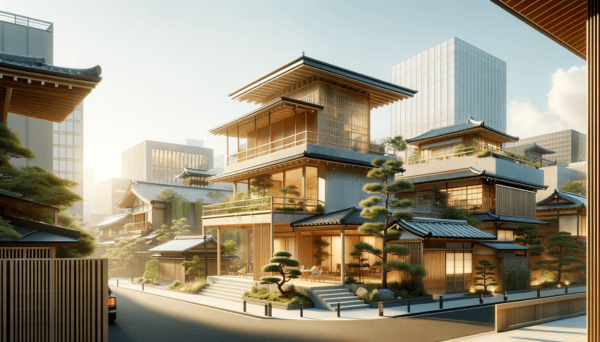
Nihon Kenchiku: The Essence of Japanese Architecture
“Nihon Kenchiku”, the traditional Japanese architectural style, has profoundly influenced modern Japanese architecture. Its minimalist aesthetics, natural integration, and harmonious balance form the core of contemporary architecture in Japan.
Key Characteristics of Japanese Architecture
Japanese architecture is defined by three primary characteristics:
1. Harmony with Nature: Emphasizing the connection between the built and natural environment.
2. Minimalism: Focusing on simplicity and the elimination of unnecessary elements.
3. Flexibility and Adaptability: Creating multipurpose spaces reflecting life’s fleeting nature.
Showcasing Japan’s Architectural Excellence : 11 Top Architecture Firms in Japan
Tetsuo Kobori Architects + Daiwa House Industry Co. + Fujita Corporation
- Project: MORI NO KAISHO / MEETING PLACE OF FOREST
- Location: Nara, Japan

MORI NO KAISHO
An organic, earth-inspired design featuring local wood and natural light, fostering ancient cross-role communication with modern eco-technology.
Aisaka Architects’ Atelier
- Project: BUILDING OF MUSIC
- Location: Tokyo, Japan

BUILDING OF MUSIC
A music-themed building with a speaker-like façade, integrating architecture and music through controlled sunlight and sound.
Nishijama
- Project: CURA GINZA OFFICE PROJECT
- Location: Ginza, Japan
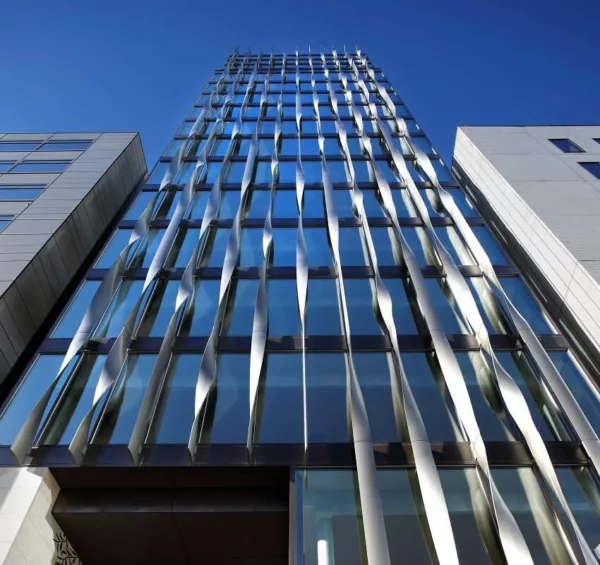
CURA GINZA OFFICE PROJECT
A joint office-shopping complex near Kabukiza, combining “Aqueducts” and “Willows” in its design, blending with Ginza’s traditional scenery.
CUBO design architect
- Project: C4L
- Location: Japan
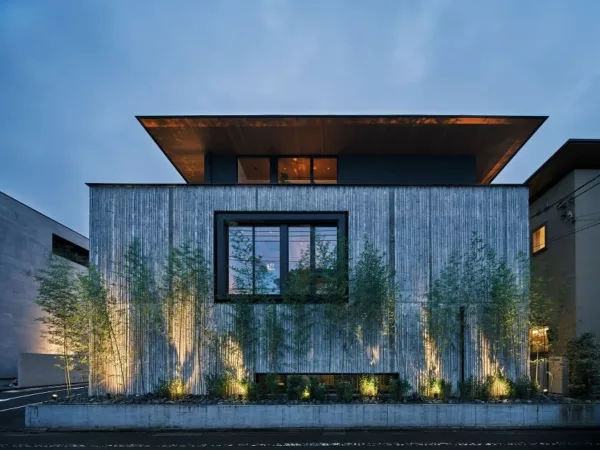
C4L
Inspired by traditional homes, focusing on natural materials and handcrafted furnishings to create restful environments with a modern twist.
JAKUETS Inc.
- Project: IWASAKI NURSERY SCHOOL
- Location: Chiba, Japan

IWASAKI NURSERY SCHOOL
A kindergarten space designed for continuous play and communication, with various interactive spaces fostering human interaction.
Shotaro Takahashi + Associates
- Project: HANARE-I
- Location: Shimane, Japan
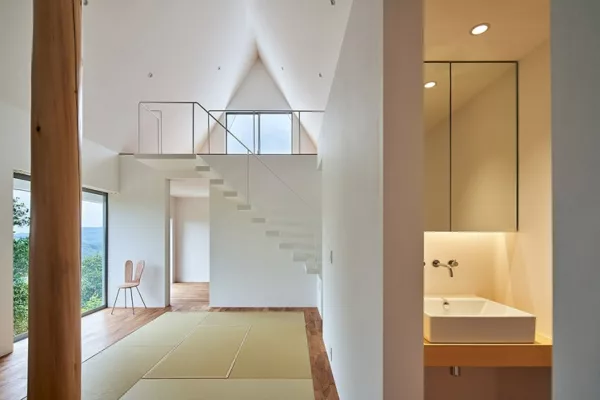
HANARE-I
A residence offering spectacular views, integrating natural landscapes into its design and respecting traditional forms with modern elements.
Ido, Kenji Architectural Studio
- Project: HOUSE IN OTA
- Location: Wakayama, Japan
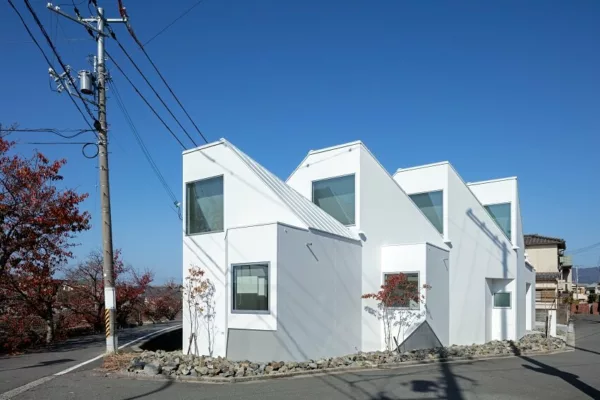
HOUSE IN OTA
A wooden single-story house with a unique sawtooth-shaped roof, creating sculptural spaces filled with natural light and minimalistic design.
GENETO Architect’s
- Project: KANOLLY RESORTS
- Location: Nagano, Japan
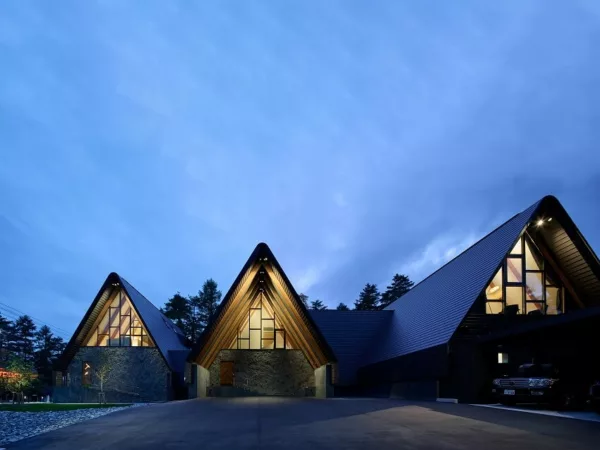
KANOLLY RESORTS
A hotel designed to let guests enjoy Hakuba’s natural beauty, embodying Japanese wabi-sabi and integrating with natural surroundings.
Ryuichi Sasaki Architecture, Kiz Architects with Escenario, Shukou Kenetsu
- Project: CUADRO NAKANO NORTH
- Location: Tokyo, Japan
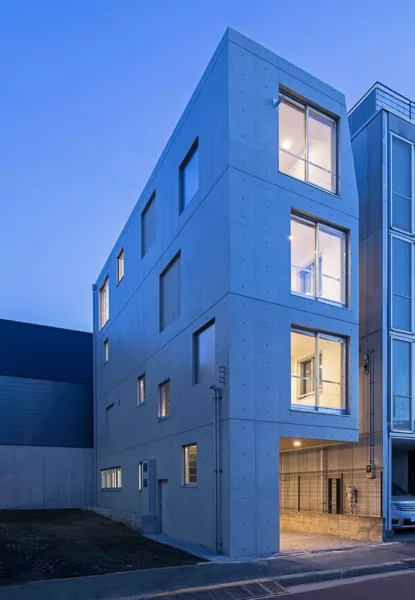
CUADRO NAKANO NORTH
A residential complex in Tokyo’s dense urban area focusing on natural energy and comfort, maximizing space with smart design choices.
intoRAW
- Project: SATOYAMA SATELLITE OFFICE
- Location: Gifu, Japan

SATOYAMA SATELLITE OFFICE
Revitalizing an area influenced by Satoyama culture, emphasizing harmonious coexistence between humans and nature using local materials.
Ateliers Takahito Sekiguchi
- Project: HAIR ROOM TOARU
- Location: Saitama, Japan
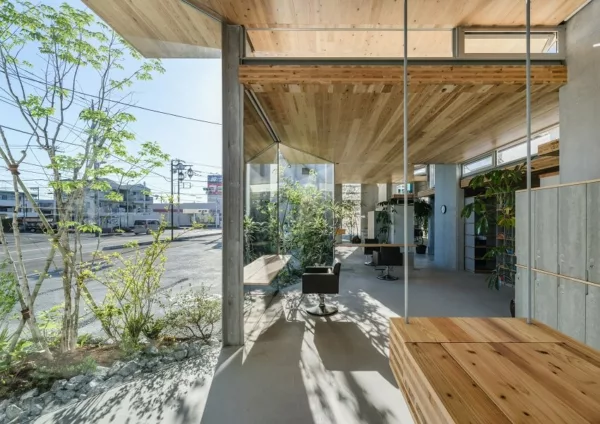
HAIR ROOM TOARU
A hair salon in a rural area using small active elements like mirrors and wooden counters, creating a dynamic space blending past and present.
A Journey Through Japan’s Architectural Innovation
In conclusion, these 11 Japanese architecture firms show excelent examples of how to merge traditional Japanese architectural principles with modern innovation. Their projects, celebrated and recognized globally, offer a glimpse into the future of architecture, where tradition and modernity coexist in harmony. Their innovative designs and thoughtful utilization of space serve as a testament to the enduring impact and versatility of Japanese architecture.
Interior Architectural Photography: Capturing Essence and Functionality
Interior architectural photography is a specialized artistic field that goes beyond simply taking pictures of indoor spaces, aiming to capture the atmosphere, design, and creative style of interiors. This type of photography is crucial in displaying the architectural details of various spaces, from comfortable residential corners to impressive commercial environments. It’s not just about taking photos; it requires a deep understanding of the interaction between light and space, the balance of design elements, and the stories behind each setting. Photographers in this area need to have a keen attention to detail, a strong understanding of architectural concepts, and excellent photography skills to truly represent the core of interior design.
The Range of Spaces
Within the range of interior architectural photography, residential photography provides a look into private and cozy living spaces, showing the essence of homes in their various forms. Conversely, commercial photography highlights the lively and practical sides of business environments, from sleek office spaces to lively shopping areas, with each photo highlighting the distinct design and usefulness of these places. This diverse approach not only demonstrates the innovative ideas and creativity of architects and designers but also enhances the audience’s appreciation for the variety and beauty of architectural design in our surroundings.
Bridging the gap between art and architectural functionality, the following collection of photographs exemplifies the peak of interior architectural photography, each capturing more than just the physical space but the emotion and intention behind it.
18 Exceptional Interior Architectural Photographs
1. Abrahamic Family House by Victor Romero
Interior Architecture Photography of the Year and Winner in Cultural Interior
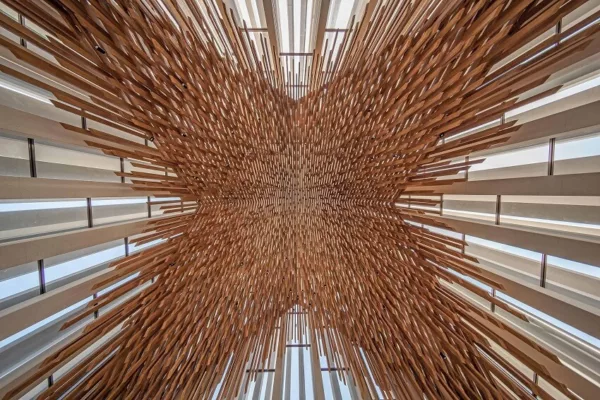
– A masterpiece capturing the cultural and spiritual significance of the space.
This project skillfully shows how three different religious spaces can exist together in harmony. It highlights the detailed architecture and the deep meanings that each building represents.
2. Series Architectural Detail by Danica O. Kus Photography

– An exquisite depiction of interior details.
This series beautifully captures the small, often overlooked details in interior design. It brings attention to the fine textures, patterns, and shapes that make these spaces elegant and complex.
3. 147 Work Station by Shawn Liu Studio
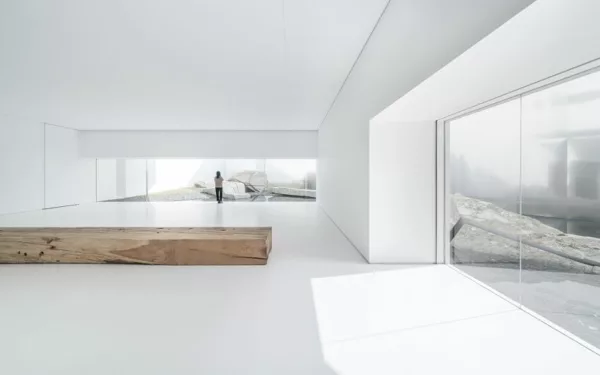
– A cultural interior that speaks volumes through its design.
This workspace is captured in a way that emphasizes its modern, dynamic environment, reflecting a combination of functionality and artistic expression.
4. Void by Yuval Shiboli
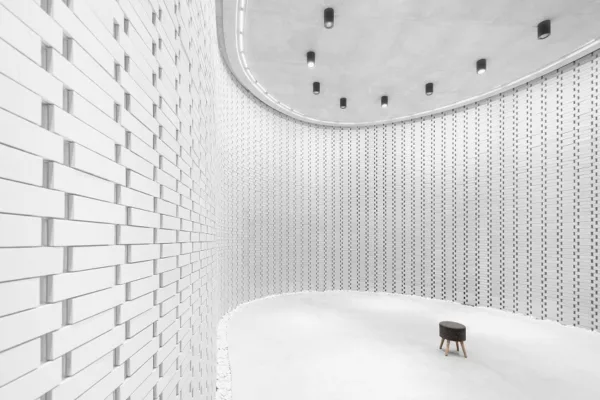
– Public interior photography that captures the essence of spaciousness.
The ‘Void’ project showcases how empty space can be used in building design to create a strong visual effect, making the inside of the building seem larger and more open.
5. Stuttgart Main Station by HGEsch Photography
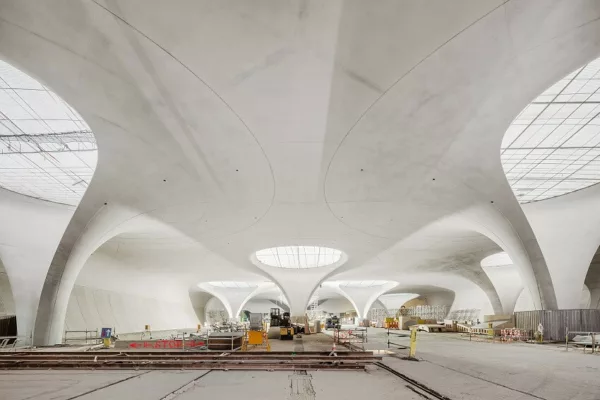
– A public interior masterpiece showcasing modern design.
This project showcases the blend of old architectural styles with new design, showing how the station serves as a busy, up-to-date center for transportation.
6. AUTOGRAPH COLLECTION HOTEL in NANJING, CHINA by BeyondVision Photography
Winner in Hospitality Interior
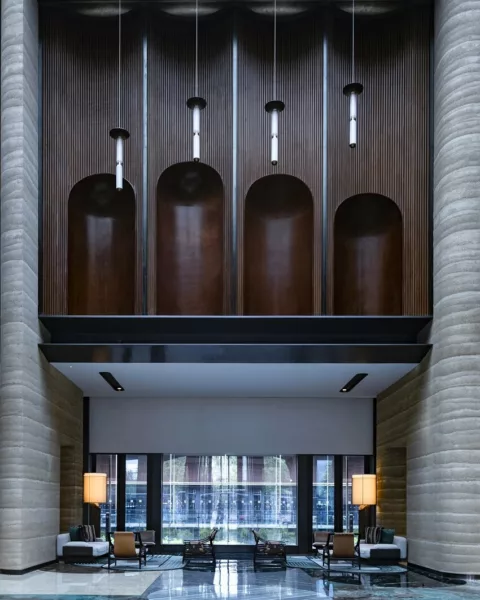
– Hospitality interior photography at its finest.
The images capture the luxurious and dynamic design of the hotel, reflecting its unique character and the cultural essence of Nanjing.
7. New Maximalism in Milan by Francesco Dolfo
Winner in Residential Interior
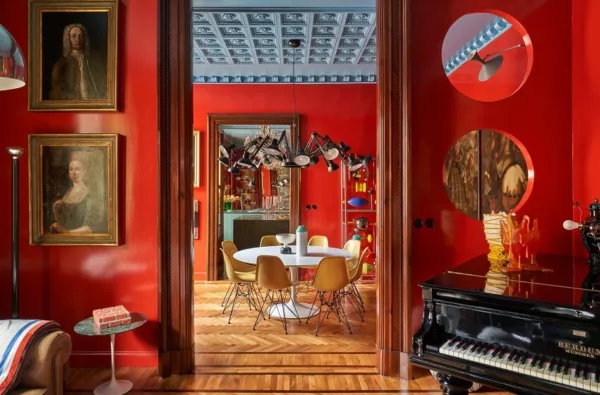
– A residential interior that redefines luxury and comfort.
This project explores the concept of maximalism in interior design, showcasing a rich array of textures, colors, and patterns that create a vibrant and luxurious living space.
8. Harmonious Space by YEP BAO
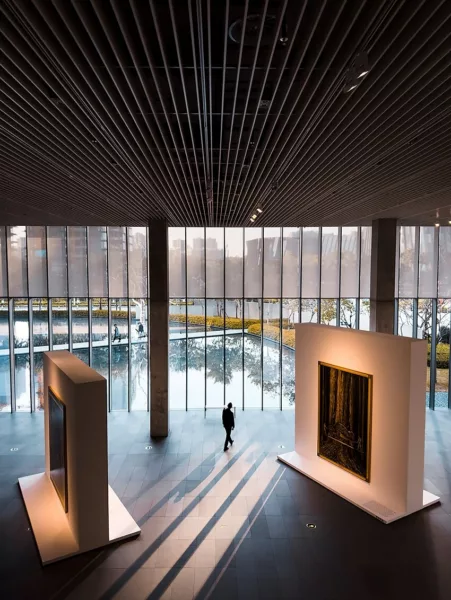
– A cultural interior that is a symphony of design elements.
The photography captures the seamless integration of traditional and modern design elements, creating a space that is both culturally significant and aesthetically pleasing.
9. Memories through the liquid desert waves by Anamaria Chediak Photography
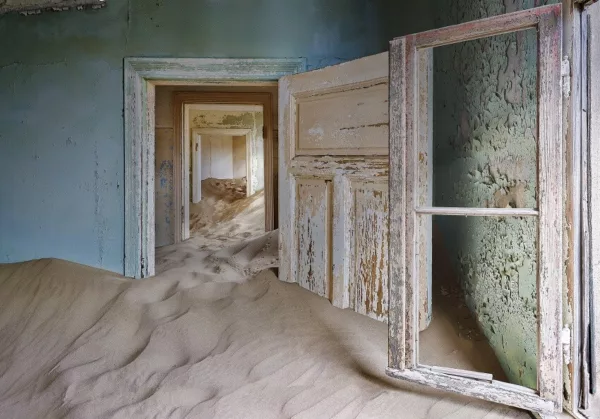
– Capturing interior details with a unique perspective.
This project emphasizes the smooth and graceful aspects of design, similar to waves moving through a desert, drawing attention to the creative use of different materials and shapes.
10. Modern sacred places by Ryû JANVIER

– Historic interior photography that tells a story.
This project captures the feel of modern sacred places, mixing respect for history with modern design to create a peaceful and spiritual setting.
11. OLDERFLEET by Tim Griffith Photographer
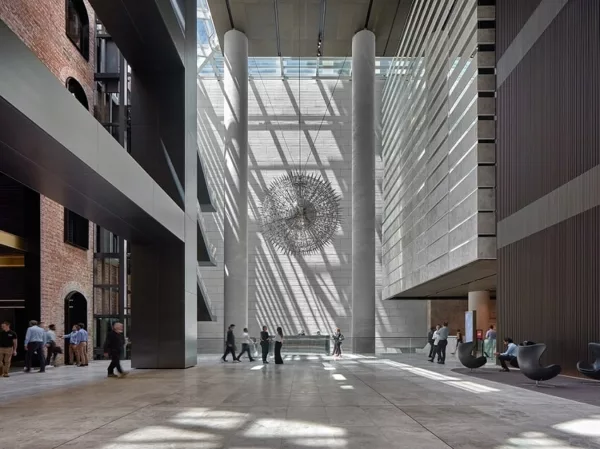
– A public interior that combines history with modernity.
This project displays the detailed work of restoring and updating an old building, focusing on the careful mix of keeping historical elements while adding modern features.
12. House ZGo by Lars Gruber Architekturfotografie
Winner in Sustainable Interior
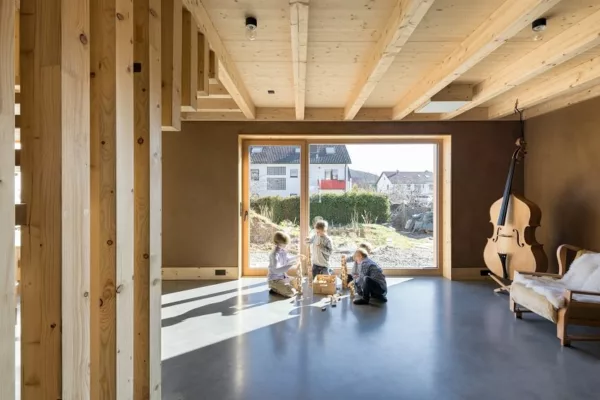
– A sustainable interior that’s both efficient and aesthetically pleasing.
This project is a clear example of environmentally friendly design, showcasing creative approaches that improve sustainability while still maintaining a stylish look.
13. Beeah Headquarters, Sharjah by Victor Romero
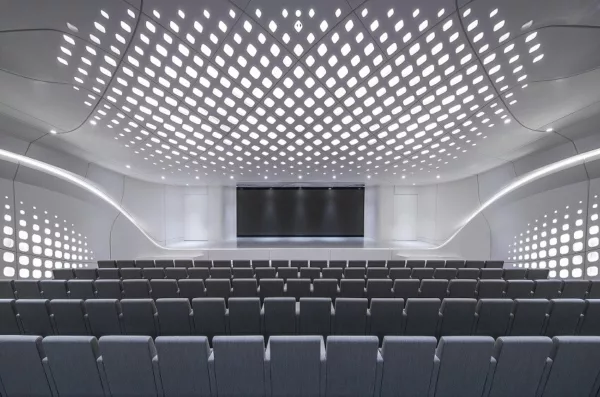
– An ‘other’ interior category, blending innovative design with functionality.
The project captures the futuristic and sustainable design of Beeah Headquarters, reflecting its commitment to environmental excellence.
14. Papieri by Ramona Elena Balaban
Winner in Residential Interior
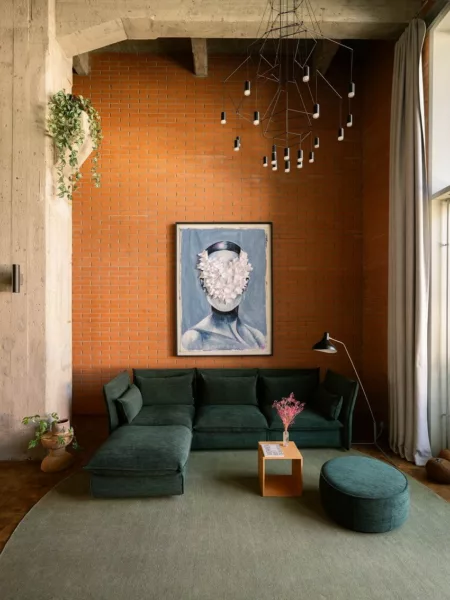
– A residential interior that displays comfort and style.
The project showcases the transformation of a former paper factory into a modern living space, combining industrial elements with contemporary design.
15. The Chemistry Between Armchair and Piano by Nimkat Studio
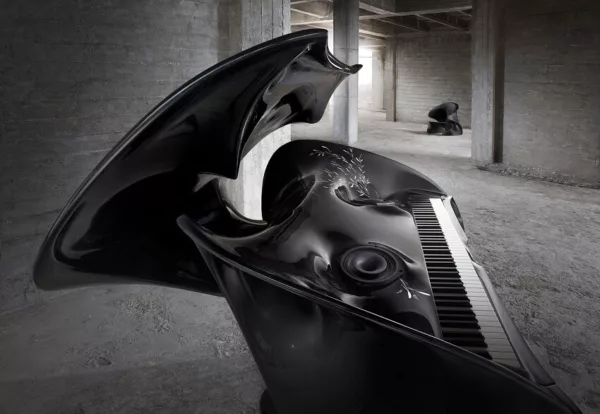
– Showcasing interior products in harmony.
This project focuses on the relationship between furniture and space, highlighting how individual pieces can complement and transform an interior.
16. The Pocket Theatre by Ramona Elena Balaban

– A cultural interior that is both intimate and inviting.
The project captures the unique design of a small theater, emphasizing its cozy atmosphere and the creative use of limited space.
17. MOL by HGEsch Photography
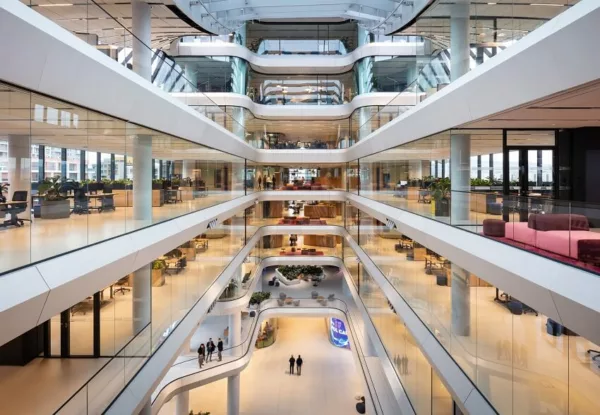
– Commercial interior photography that captures the essence of corporate style.
This project shows the modern and lively character of a corporate space, displaying a design that encourages both productivity and creativity.
18. Dermatology Clinic by Nimkat Studio
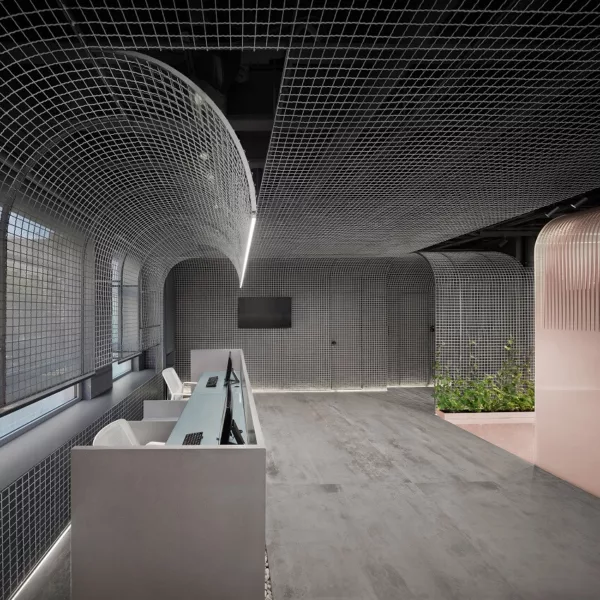
– A healthcare interior that combines functionality with serene aesthetics.
The project focuses on creating a calming environment for patients, utilizing a minimalist design that is both modern and therapeutic.
Interior Architectural Photography: Capturing More Than Just Spaces
Interior architectural photography is about much more than just taking pictures of buildings. It’s a way to tell stories using images. Each photo is a window into a carefully designed world, where light, shapes, and textures all have a story to tell. This kind of photography doesn’t just show what a place looks like; it captures the feeling of the design, the culture around it, and the emotions that space can bring out.
The 18 photos, chosen by Architecture Photography MasterPrize (APMP), are great examples of this. They are not just proof of someone’s skill with a camera; they are beautiful expressions of building design. From the peaceful Abrahamic Family House to the modern Stuttgart Main Station, these photos show a wide range of building styles. Each one tells its own story, whether it’s the colorful energy of a home in Milan or the quiet calm of a dermatology clinic. Interior architectural photography shows us how different places can make us feel different things – from wonder in large public spaces to coziness in smaller, more private areas.
These 18 photos show what interior architectural photography is really about – a mix of creative vision, skill with a camera, and the ability to tell a story. They highlight the unseen beauty in buildings and invite us to look closer, to see the stories woven into these places. When we look at these photos, we’re not just seeing spaces; we’re experiencing the designs, cultures, and emotions captured in a single, special moment.
Architecture firms in the UK operate within a dynamic mixture of historical elegance and contemporary innovation in the United Kingdom’s architectural landscape. With over 35,000 architects in the UK, the sector is not only large but vibrantly competitive. This diverse environment of British architects drives a relentless pursuit of design excellence and innovation. Amidst this active scene, certain architecture firms have established a niche for themselves, standing out through their exemplary projects and significant influence on both the national and global stages.
Spotlight on Excellence: The Top 5 Architecture Firms in the UK
The following firms, all distinguished winners of the architecture award Architecture MasterPrize (AMP), represent some of the most innovative and influential architectural achievements in the UK. These firms, recognized for their outstanding contributions, showcase a broad range of styles and specialties, reflecting the diversity and dynamism of the UK’s architecture scene.
1. James Gorst Architects
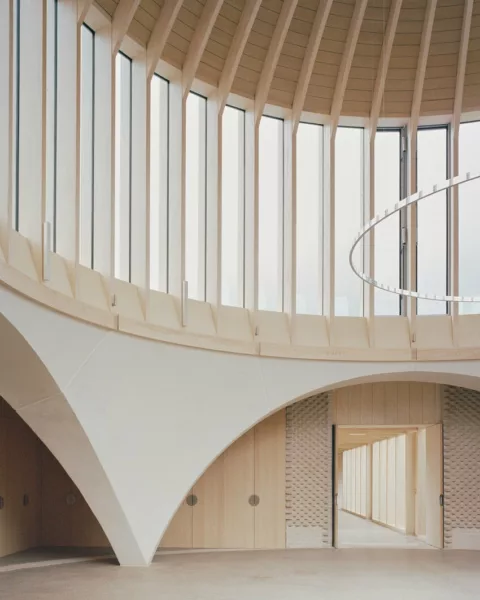
New Temple Complex in London
Leading the way in sustainable and culturally sensitive design, James Gorst Architects’ New Temple Complex in London is a standout example of modern architecture. This project, for the White Eagle Lodge, harmonizes sacred and secular functions within an environmentally conscious framework. The firm’s principle of minimal environmental impact is evident in its use of natural landscapes and sustainable materials, setting a standard for future architectural endeavors.
2. Kohn Pedersen Fox Associates
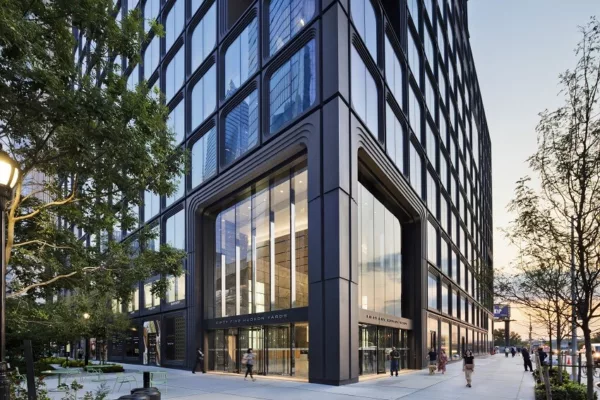
55 Hudson Yards in New York
With a global footprint, Kohn Pedersen Fox Associates demonstrates excellence in versatile architectural design. Their projects, such as 55 Hudson Yards in New York and the Shenzhen Center in China, showcase a blend of contemporary aesthetics with functional effectiveness. These designs, celebrated for their sleek forms and urban integration, have earned international acclaim, including prestigious awards in commercial and high-rise architecture.

Shenzhen Center in China
3. Studio Seilern Architects
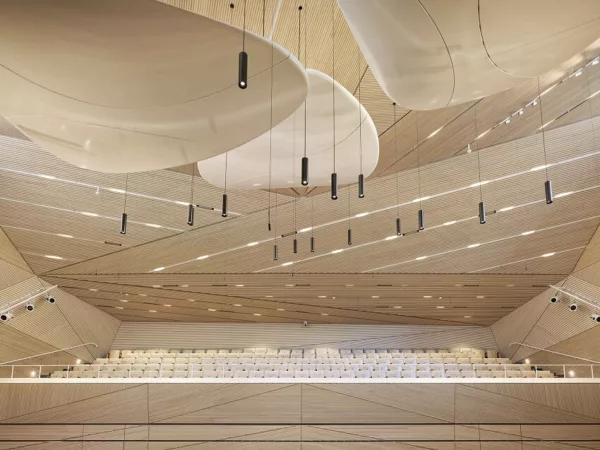
Andermatt Concert Hall in Switzerland
Studio Seilern Architects stands out in the realm of cultural architecture. Their designs, like the Andermatt Concert Hall in Switzerland and the El Gouna Conference and Cultural Centre in Egypt, are not just buildings but cultural landmarks. They create spaces that resonate with aesthetic beauty and serve as hubs for cultural engagement, thus enriching the communities they are part of.
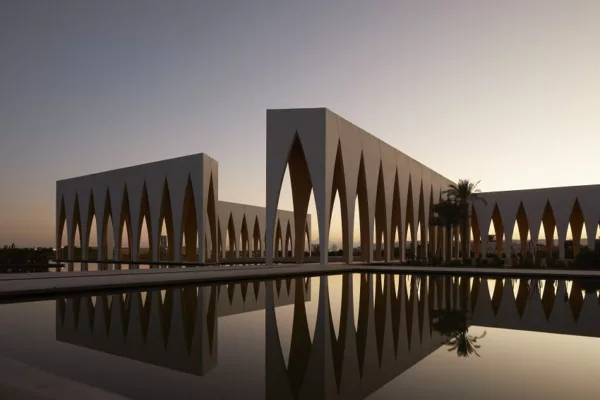
El Gouna Conference and Cultural Centre in Egypt
4. Studio Egret West
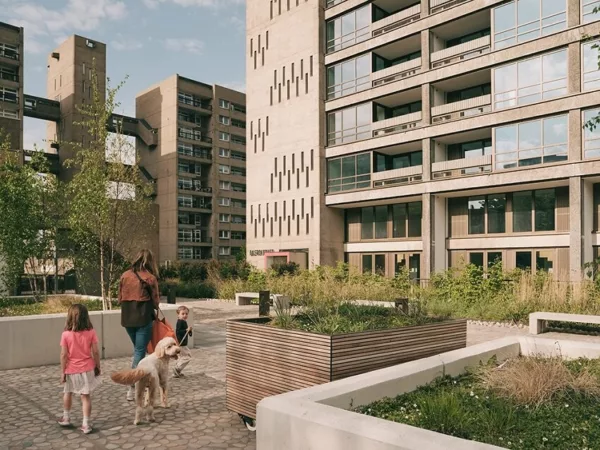
Balfron Tower in East London
Renowned for their restorative and innovative urban designs, Studio Egret West has made significant contributions to the UK’s urban landscape. Projects like the Balfron Tower in East London and Mayfield Park in Manchester exemplify their philosophy of blending historical reverence with modern functionality. Their work in transforming urban spaces into vibrant, liveable communities is a clear demonstration of their visionary approach.
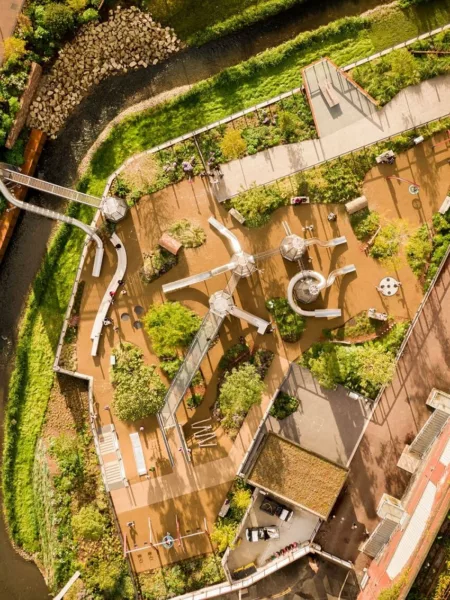
Mayfield Park in Manchester
5. Studio Woodroffe Papa
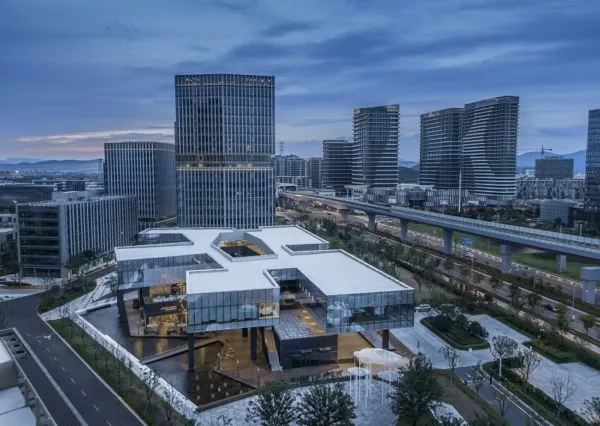
Cloud Valley Hub in China
In the field of mixed-use architecture, Studio Woodroffe Papa’s Cloud Valley Hub stands as an outstanding example of innovation and community-centric design. This project illustrates their proficiency in creating spaces that encourage communal interaction and blur the boundaries between different functional areas, thereby creating a seamless, integrated experience.
The Significance of Architectural Awards in the UK
These awards are more than just accolades; they act as a benchmark for excellence in the field. They play a crucial role in highlighting the industry’s dedication to innovation, sustainability, and outstanding design, inspiring both established and aspiring architects. These acknowledgments not only honor current achievements but also set a standard for future architectural endeavors.
The Future Trajectory of the Architecture Industry in the UK
Looking forward, the UK’s architecture industry is on the brink of significant change and advancement. With the adoption of new technologies like Building Information Modelling (BIM) and a strong focus on sustainable design, British architects are leading the way in international architectural innovation. The industry is moving towards a future where sustainable development, technological advancements, and a commitment to outstanding design are the norms.
UK Architecture Firms Leading Global Innovation and Excellence
The architecture firms in the UK are more than just contributors to the skyline; they are the leaders of architectural thought and innovation. The top five firms highlighted here are representative of the excellence and diversity in the British architecture. Their work not only enriches the UK’s architectural landscape but also sets a global standard for design and innovation. These firms, through their visionary projects and commitment to excellence, continue to inspire the future of architecture not only in the UK but across the world.
In the realm of modern urban architecture, high-rise buildings stand as resplendent symbols of progress, innovation, and luxury. These towering marvels, commonly known as skyscrapers, have not only transformed city skylines but also redefined the very concept of contemporary living. From their soaring heights to their intricate designs, high-rise buildings transcend mere structural elements; they represent a fusion of engineering prowess and artistic expression that epitomizes the essence of 21st-century urban lifestyles.
In this captivating journey through architectural ingenuity, we embark on a global exploration of some of the world’s most awe-inspiring high-rise buildings, each offering a glimpse into the fusion of luxury and innovative design.
Periférico 2008: A Verdant Vertical Haven in Mexico City
Venturing southward to the bustling heart of Mexico City, we encounter the remarkable Periférico 2008. Crafted by the visionary minds at BRAG arquitectos, this multi-unit residential gem redefines the very concept of vertical living. Soaring to a majestic height of 115.00 meters, this high-rise building, orchestrated by Cristian Aguilar and Santiago Morales Broc, seamlessly integrates urban luxury with a touch of nature.
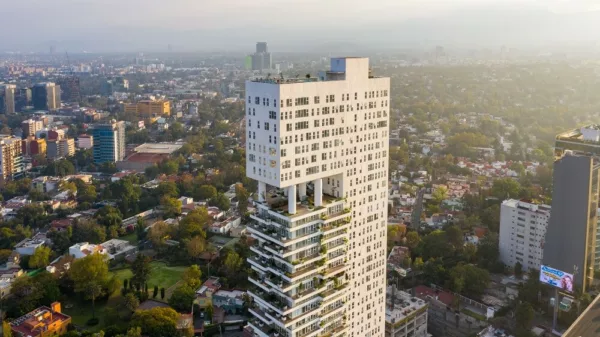
Periférico 2008
Noteworthy is the ingenious incorporation of gardens and green terraces, accounting for an astonishing 20% of the project’s construction area. This innovation culminates in the creation of a lush vertical garden, adorned with nearly 200 trees—a living testament to the harmonious coexistence of modern urban living and nature.
Shenzhen Houhai Hongtu Innovation Plaza: A Jewel in China’s Skyline
Our exploration leads us to the vibrant city of Shenzhen, China, where the Shenzhen Houhai Hongtu Innovation Plaza stands tall and proud. A creation of the esteemed CCDI Group – 21 Design, this 262-meter architectural marvel is a striking testament to engineering prowess and innovative design.
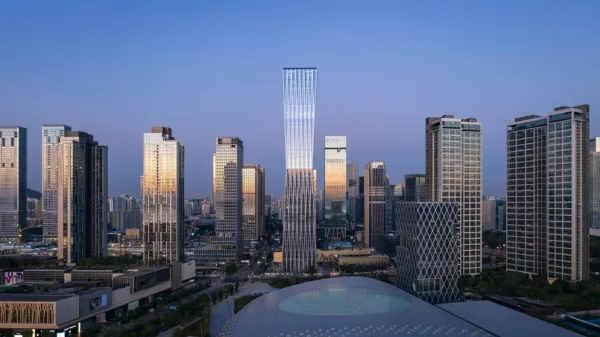
Shenzhen Houhai Hongtu Innovation Plaza
The plaza’s facade, characterized by its modular diamond-shaped curtain wall, captures the essence of modern luxury. Notably, the external structural frame, an ingenious steel rhombus oblique grid, seamlessly blends form and function, resulting in an architectural masterpiece that effortlessly integrates with its urban surroundings.
Pendrell: Vancouver’s Waterfront Elegance
Turning our gaze to the stunning waterfront of Vancouver, Canada, the awe-inspiring Pendrell comes into view. Conceptualized by the ingenious minds at Henriquez Partners Architects, led by the visionary Gregory Henriquez, this 21-story high-rise stands as a testament to architectural elegance and modern luxury.
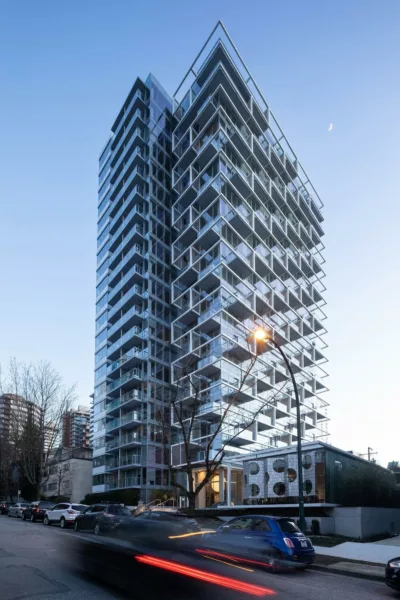
Pendrell
Embracing the city’s rich architectural heritage, Pendrell harmoniously fuses contemporary elements with traditional design, featuring concrete construction and ribbon windows that pay homage to local architecture. The unifying steel frame, reminiscent of cargo ships in the nearby bay, adds an exquisite touch to the building’s facade, seamlessly blending maritime inspiration with urban sophistication.
One Vanderbilt: A Grand Symphony in Midtown Manhattan
Amid the bustling streets of New York City, the iconic One Vanderbilt emerges as a beacon of architectural prowess and urban rejuvenation. Conceived by the acclaimed Kohn Pedersen Fox Associates, under the visionary guidance of James von Klemperer, this high-rise building represents the epitome of contemporary luxury.
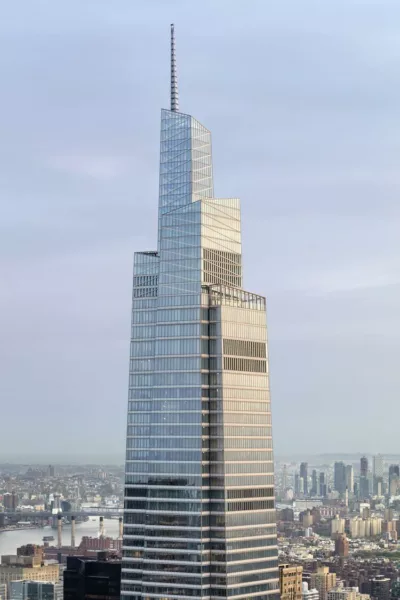
One Vanderbilt
Its distinct massing, characterized by interlocking, tapering volumes, pays homage to iconic structures like the Chrysler and Empire State Buildings. The meticulously crafted angled cuts create an engaging visual procession, ultimately revealing the majestic cornice of the historic Grand Central Terminal. One Vanderbilt’s remarkable fusion of modern functionality and historical reverence stands as a testament to luxury’s evolution in the urban landscape.
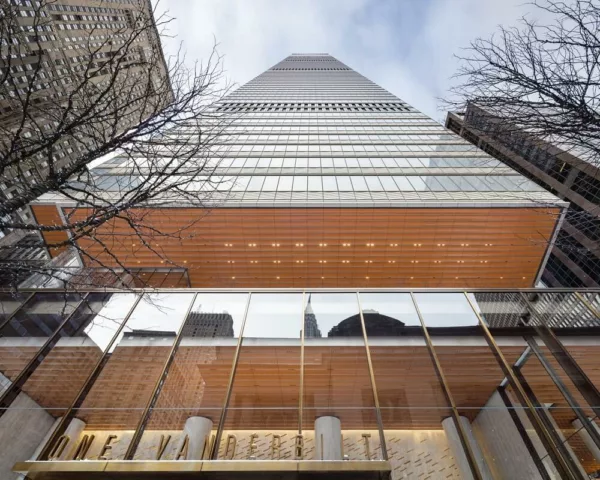
One Vanderbilt (striking perspective)
The Bryant: Manhattan’s Timeless Elegance
Nestled amidst the vibrant streets of Midtown Manhattan, The Bryant showcases a timeless fusion of luxury and architectural sophistication. Conceived by the renowned David Chipperfield Architects, helmed by the visionary David Chipperfield himself, this 32-story tower stands tall as a beacon of high-rise elegance.
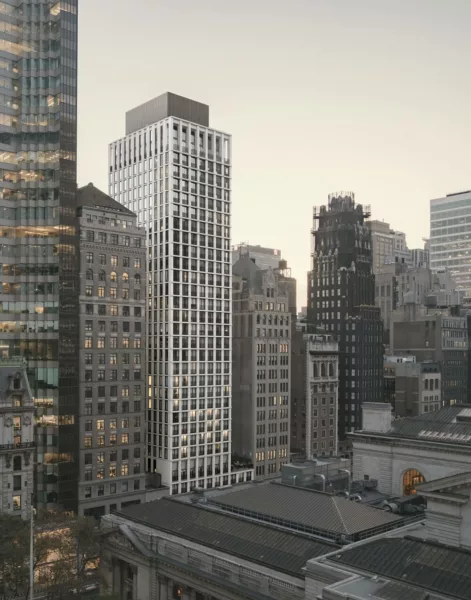
The Bryant
The facade’s concrete composition, incorporating diverse stone aggregates, pays homage to neighboring historic structures. The polished precast concrete slabs and columns follow a rhythmic grid pattern, infusing the building’s interior spaces with a sense of architectural substance and identity. The Bryant’s harmonious blend of classical aesthetics and modern living encapsulates the very essence of urban luxury.
18 Robinson: Singapore’s Green Oasis
In the vibrant urban landscape of Singapore, 18 Robinson emerges as a testament to sustainable luxury and architectural ingenuity. Designed by the illustrious Kohn Pedersen Fox Associates, under the visionary leadership of Robert Whitlock, this high-rise gem redefines urban living with a focus on green sustainability.
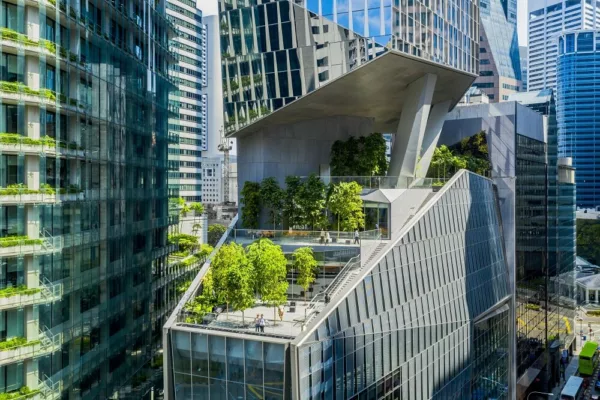
18 Robinson
The faceted tower design not only captures a sense of lightness and airiness but also dedicates a significant portion of its site area to publicly accessible green spaces. This seamless integration aligns with Singapore’s visionary green agenda, forging a new path for sustainable luxury in the urban context.
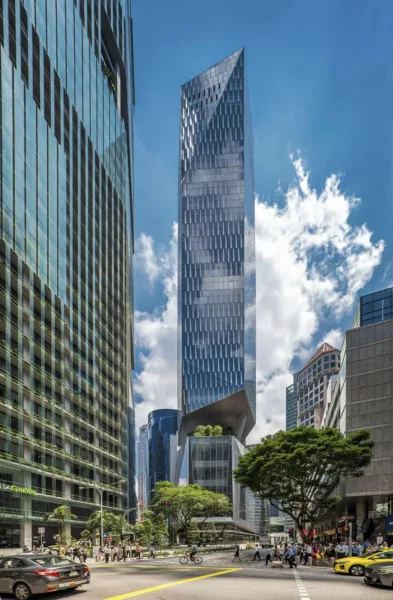
18 Robinson (full-size view)
Elevating Urban Grandeur: The Essence of High-Rise Buildings as Architectural Icons
High-rise buildings are more than mere structures. They are embodiments of architectural innovation, luxury, and the human pursuit of engineering excellence. From the verdant vertical oasis of Periférico 2008 to the dazzling diamond-shaped brilliance of Shenzhen’s skyline, each high-rise we’ve traversed represents a harmonious blend of cutting-edge design and opulent living.
As cities continue to evolve and transform, high-rise buildings remain steadfast as symbols of progress, elegance, and the soaring heights of luxury.
Singapore, a modern and sustainable architecture hub, is home to some of the world’s most innovative architecture firms. In this article, we spotlight six of the top architecture firms in Singapore, each recognized for their exceptional contributions to the field. These architecture firms in Singapore are at the leading edge of shaping the country’s architectural landscape with their groundbreaking designs and sustainable practices.
From educational institutions to commercial marvels, let’s explore the award-winning architecture firms in Singapore and discover what sets them apart in the industry.
Top Architecture Firms in Singapore
1. RSP Architects Planners & Engineers Pte Ltd
Winner in Institutional Architecture
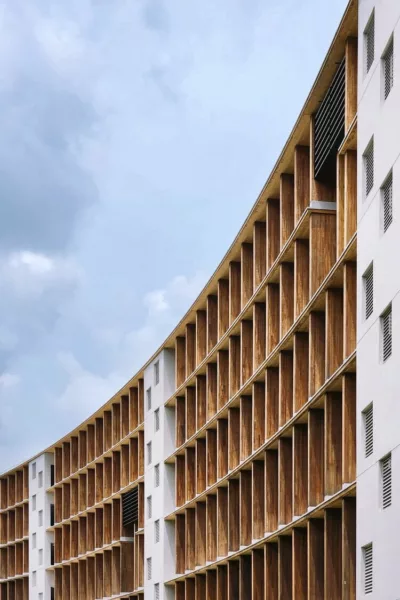
RSP Architects Planners & Engineers Pte Ltd stands out for their exceptional work in institutional architecture. Their project, GAIA, has been awarded the Best of Best in Institutional Architecture. This 6-storey Mass Engineered Timber (MET) building is located at Nanyang Technological University (NTU) in Singapore. The building features teaching spaces, a research center, faculty offices, a basement, and an M&E ancillary block.
The innovative use of MET components, prefabricated off-site and assembled on-site, significantly reduces construction time and manpower requirements. GAIA is a testament to RSP’s commitment to sustainable architecture in Singapore, blending functionality with eco-friendly design principles. This project reinforces their reputation as one of the top architecture firms in Singapore.
2. CE-ST Design Studio
Winner in Commercial Architecture
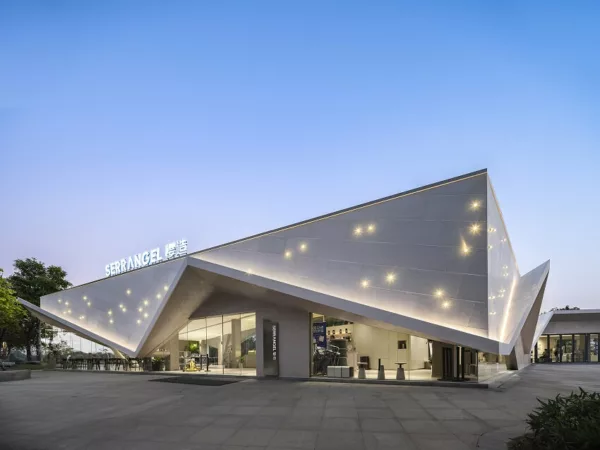
CE-ST Design Studio has made a mark with their project, the Serrangel Art Pavilion, located in Foshan, China. This award-winning project involved the restoration and adaptive reuse of an abandoned public rest shelter. The transformed structure now serves as a community art space, promoting social connections among local residents.
The pavilion’s façade is decorated with recycled glass mosaics, reflecting the client’s dedication to art and sustainability. CE-ST’s ability to comply with strict refurbishment regulations while creating a lively community space highlights their expertise in modern architecture and sustainable design. Their innovative approach places them among the notable architecture firms in Singapore.
3. SAA Architects
Winner in Healthcare / Wellness

Hainan Bo’ao Lecheng International Healthcare Incubator Hub
SAA Architects excels in creating healthcare environments that prioritize patient well-being and sustainability. Their project, the Hainan Bo’ao Lecheng International Healthcare Incubator Hub in China, has been recognized for its innovative approach to healthcare architecture.
The hub integrates medical research facilities with green spaces, promoting a healing environment for patients. By incorporating nature into the building’s design, SAA Architects demonstrate their commitment to landscape architecture in Singapore, creating spaces that benefit both people and the environment. This achievement underscores their status as one of the leading architecture firms in Singapore.
4. DP Architects Pte Ltd
Winner in Commercial Architecture
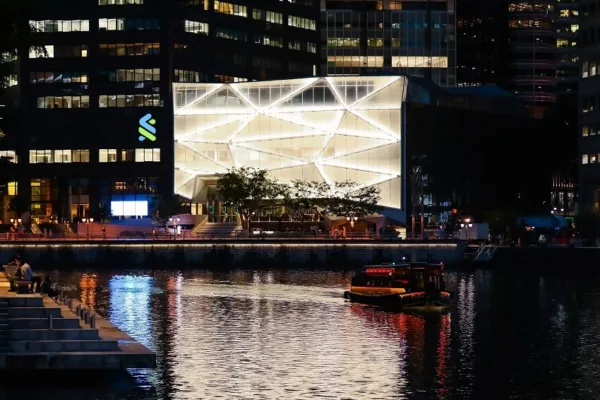
DP Architects Pte Ltd has transformed 6 Battery Road into a landmark of modern architecture in Singapore. This project involved renewing the low-rise podium into a dynamic lifestyle attraction. The patterned glass façade, inspired by the Singapore River, reflects the dynamic urban environment.
The project features crystalline forms cascading over the façade and rooftop pavilions, creating a visually striking architectural object. DP Architects’ ability to blend aesthetic appeal with functional design has earned them recognition in the commercial architecture sector. Their innovative designs position them as a top choice among architecture firms in Singapore.
5. Formwerkz Architects
Winner in Installations & Structures
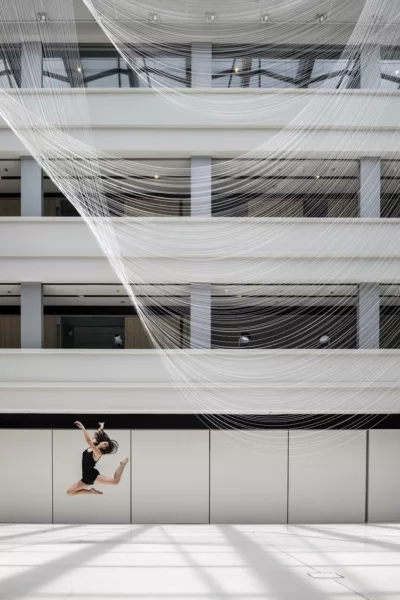
Formwerkz Architects is renowned for their innovative installations and structures. Their project, Twisted Paths, was the highlight of Singapore Design Week 2019. This hanging sculpture, located in the atrium of the National Design Centre, complements the space without dominating it.
The sculpture’s design allows visitors to experience the surrounding exhibits without distraction, showcasing Formwerkz Architects’ ability to integrate art seamlessly into architectural spaces. Their work exemplifies modern architecture in Singapore, pushing the boundaries of design and functionality. This project further enhances their reputation as one of the top architecture firms in Singapore.
6. SUTD Advanced Architecture Laboratory
Winner in Cultural Architecture

The SUTD Advanced Architecture Laboratory has created a landmark with The Future of Us Pavilion at Gardens by the Bay. This project integrates a detailed perforated skin with the natural environment, offering visitors a climatically comfortable and visually stunning experience.
The pavilion serves as a public space for community and cultural events, representing the concept of future nature. SUTD’s innovative approach to cultural architecture in Singapore highlights their ability to create spaces that engage and inspire the public. Their contributions make them a standout among architecture firms in Singapore.
Architectural Innovation in Singapore
The architecture firms in Singapore mentioned above are leaders in the architectural community. Their award-winning projects showcase their dedication to sustainable and innovative design. From institutional buildings to cultural pavilions, these architecture firms in Singapore are shaping the future of architecture in the city and beyond.
As Singapore continues to evolve, these top architecture firms will play a crucial role in creating sustainable, functional, and aesthetically pleasing environments. Their contributions to the field are a reflection of the city’s lively and dynamic architectural landscape.
For more information on the latest trends and award-winning projects in architecture, visit Architecture MasterPrize (AMP).
Architecture award usually serves as a testament to the creativity, innovation, and excellence displayed by architects and design professionals around the world. The Architecture MasterPrize (AMP) is one such prestigious platform that honors outstanding architectural achievements. AMP recognizes projects that push boundaries, challenge conventions, and create meaningful impacts on the built environment.
Let’s now delve into the experiences of AMP award winners, their winning projects, and, most importantly, their thoughts on the significance of receiving this esteemed recognition.
Architecture MasterPrize (AMP): Recognizing Excellence
AMP has been at the forefront of celebrating architectural ingenuity and providing an international platform to honor design excellence globally. Each year, a diverse range of projects is awarded across various categories, showcasing the versatility and brilliance of architectural concepts worldwide.
Among the winners, there are those who have achieved remarkable success in multiple years, reaffirming their commitment to pushing the boundaries of architecture.
AMP Award Winners and Their Winning Projects
William Kaven Architecture – Royal
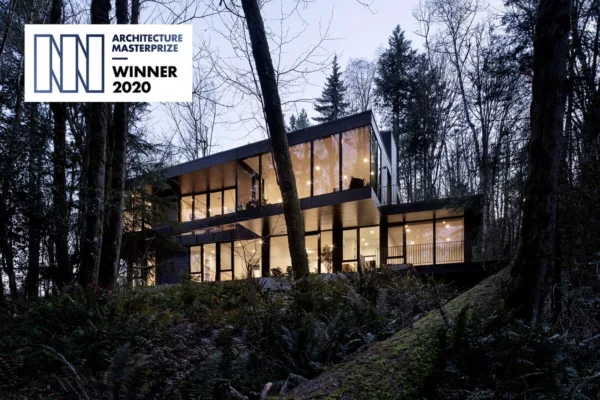
William Kaven Architecture – Royal
In 2020, William Kaven Architecture’s project “Royal” garnered the AMP award in Architectural Design / Residential Architecture – Single Family. The project’s distinctiveness lies in its seamless integration with the natural landscape while providing an unparalleled living experience.
Words of the winner of architecture award, Daniel Kaven, Partner at William / Kaven Architecture:
“Receiving AMP recognition for Royal sparked significant exposure on an international scale — not just for the project itself, but for our studio. We are honored to have the opportunity to exhibit this winning project and our studio ethos to a broad, discerning audience.“
MetropolitanmomentuM – The Metropolitan Green Core Project

Pablo and Maria with AMP Trophies – Celebrating Success of MetropolitanmomentuM
MetropolitanmomentuM’s “The Metropolitan Green Core Project” in Landscape Architecture – Urban Design has been recognized by AMP multiple times, with three awards and five honorable mentions since 2016. The project focuses on creating sustainable urban landscapes that promote green living and environmental consciousness.
Pablo Osorio from MetropolitanmomentuM expresses gratitude, saying:
“We thank Architecture MasterPrize for moving our profession forward by providing an international platform to honor and celebrate design excellence globally. We have had the opportunity to participate in it since 2016. We have been honored with three awards and five honorable mentions, and it has been an unforgettable experience. We look forward to the next Architecture MasterPrize. Thank you!“
Arseh Consulting ENgineers & Tarahan Assayesh – Azadi Roundabout – Ardabil Science Park- Golgohar Entrance
Arseh Consulting Engineers & Tarahan Assayesh’s project, “Azadi Roundabout – Ardabil Science Park- Golgohar Entrance” in Misc Architecture – Built Architecture, captivates with its artful blend of engineering and artistic expression.

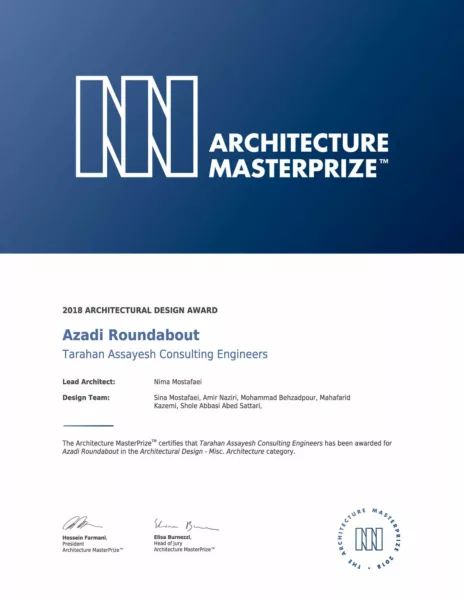
Nima Mostafaei from Arseh Consulting Engineers & Tarahan Assayesh Frim shares:
“Architecture is where art and engineering break even, yet many shall never grasp the grind through the process. Hence, gratitude to the Masterprize team, helping Architects promote their triumphs and perhaps celebrate a modicum of solace.”
Fernando Andrade & Associates – Amazon Bus Station
Fernando Andrade & Associates’ “Amazon Bus Station” in Transportation is a remarkable piece of architectural ingenuity that revolutionizes public transportation spaces.
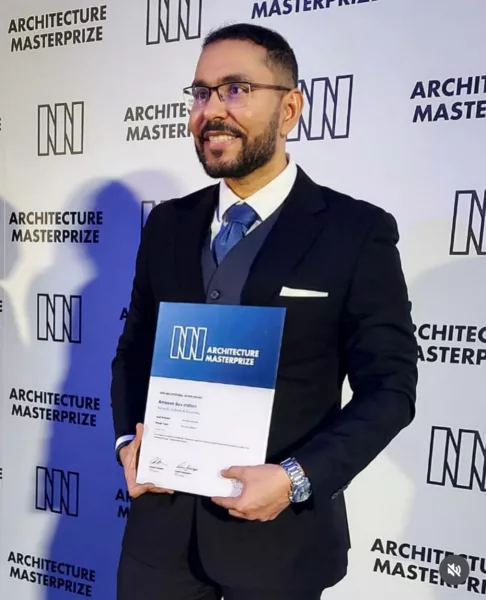
Celebration of Fernando Andrade at AMP Event – Receiving Architecture Award for “Amazon Bus Station”
Fernando Andrade himself expresses:
“Winning the Architecture Masterprize was without a doubt one of the best experiences I’ve ever had! An individual experience, no doubt, but one that multiplies new possibilities. A symbolic adventure that, on the pretext of leading me to a presumed point, allowed me to contemplate a line on the horizon.”
Hakuten Corporation – Prism
Even projects beyond conventional architecture find appreciation at AMP. Hakuten Corporation’s “Prism” in Exhibition is a testament to the versatility and inclusivity of the awards.
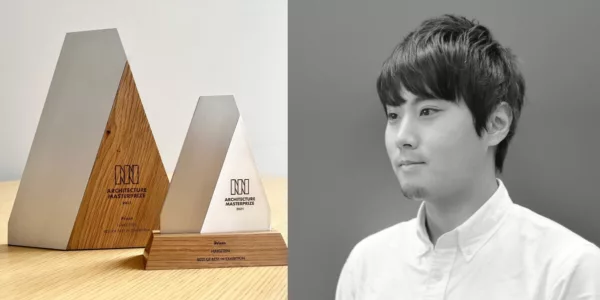
Takumi Takahashi with AMP Trophies for “Prism”
Takumi Takahashi from Hakuten Corporation expresses their gratitude, stating, “We are very fortunate to have received the award. Although my work is not architecture, we were happy that many architects were able to see our work. We appreciate the media coverage that this award has brought to us.”
Studio SKLIM – Voids Café
Studio SKLIM’s “Voids Café” in Commercial Interior design exemplifies their commitment to design innovation and sustainability, an ethos reflected in all their projects.
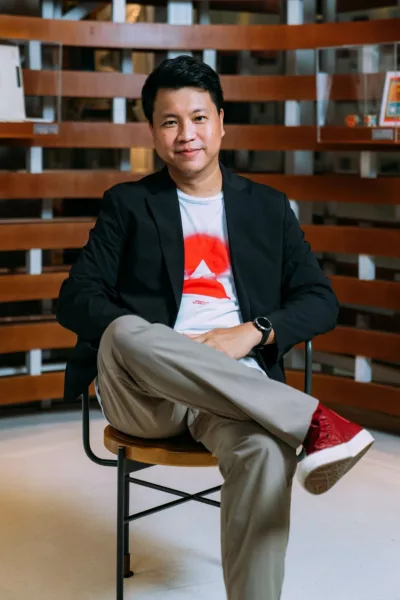
Kevin Lim -Studio SKLIM
Kevin Lim from Studio SKLIM remarks, “The Architecture Masterprize Awards have been a pivotal moment for us, providing undeniable validation for our commitment to design innovation and to challenging conventions in shaping spaces. This recognition has propelled us forward, inspiring us to pursue even more ambitious projects with a heightened focus on sustainable strategies. We are grateful for the opportunity to showcase our firm’s talent and expertise to a wider audience, and we look forward to continuing our journey of disrupting the possibilities of architecture.”
XS Space – Brooklyn Modern Garden
XS Space’s “Brooklyn Modern Garden” in Residential Landscapes showcases their dedication to creating inviting outdoor spaces that harmonize with urban environments.
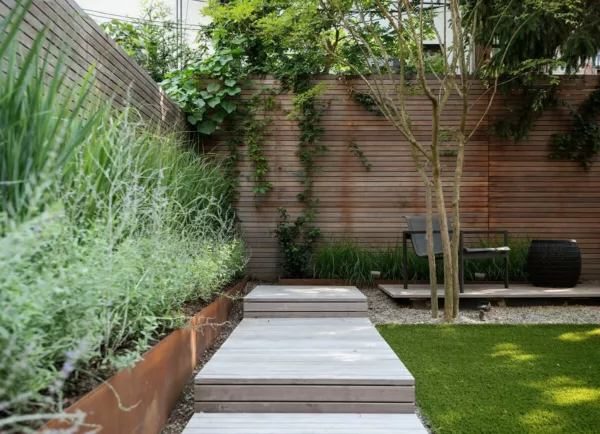
Brooklyn Modern Garden by XS Space
Julie Farris from XS Space expresses her honor, saying, “XS Space is honored to have been included among such talented designers!”
Rich Honour Design – Time Capsule, A Beauty Lab
Rich Honour Design’s “Time Capsule, A Beauty Lab” received the Interior Design Award – Best of Best, proving that architecture extends beyond physical structures.
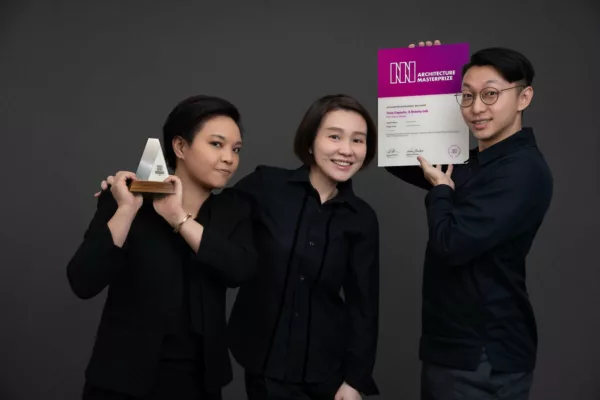
Rich Honour Design Team Trophy Celebration
Min Chien Yeh from Rich Honour Design shares their joy, “We are delighted to receive the award from AMP that makes our work even more magical after experiencing the difficulties of the epidemic. Especially in the grand event that we attended in Bilbao allowed us to meet so many international professionals. We have also gained industry acknowledgment of our strengths through our award-winning projects. It is an incomparable joy and pride to be able to have this honor. We will continue to create better works in this field and look forward to being recognized by AMP again in the future.”
Frank Machalowski – Bauhaus Dessau
Even architectural photography finds a place of honor at AMP, with Frank Machalowski’s “Bauhaus Dessau” receiving accolades for Exterior Architecture Photography (APMP).
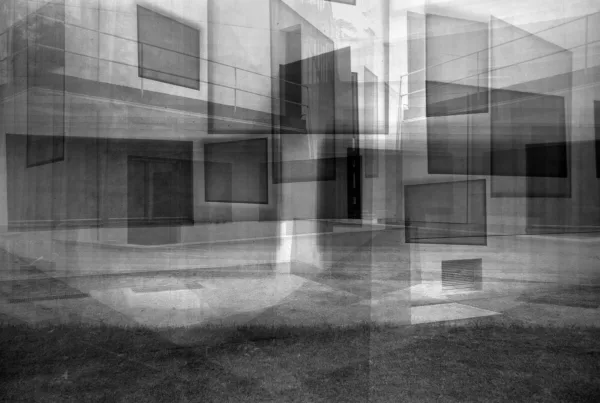
Winning photography – Bauhaus Dessau
Frank Machalowski expresses his happiness, saying, “I am happy to have taken part in this competition. I feel very honored to have won an award. That gives me confidence in my work!”
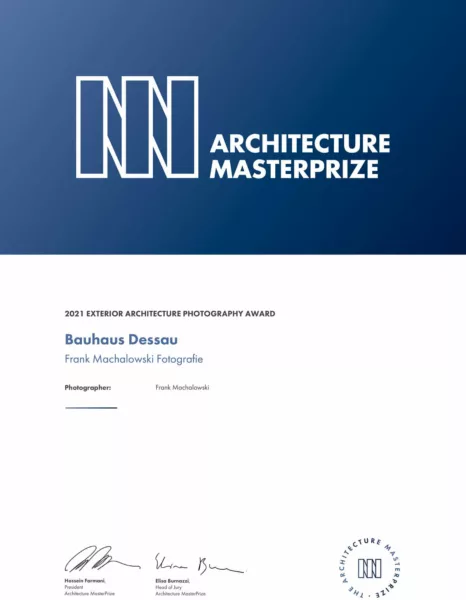
KUCZIA – The Envelon System (2022) + Avancis PowerMax (2019)
In the Products Awards category, KUCZIA’s “The Envelon System (2022) + Avancis PowerMax (2019)” showcases their dedication to innovation and sustainability.
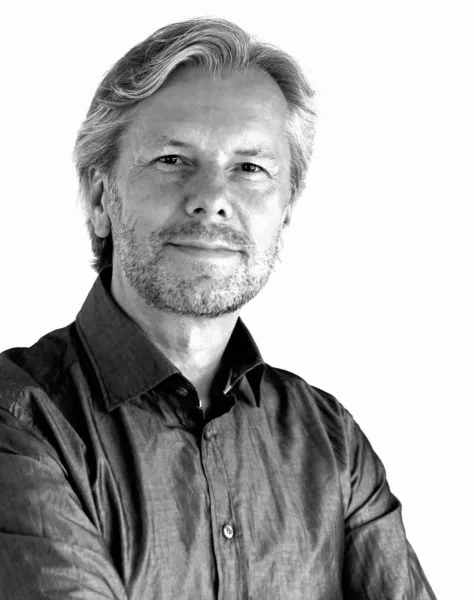
Peter Kuczia of KUCZIA
Peter Kuczia from KUCZIA proudly shares,:
“Being a two-time PRODUCT OF THE YEAR Award winner in such a distinguished competition is a great honor and a motivating confirmation for me that my design efforts make sense.”
Celebrating Excellence: The Impact of Architecture Award by AMP
The Architecture MasterPrize serves as more than just a platform for celebrating award-winning projects; it is an engine that drives innovation, inspires creativity, and provides validation to architects and design professionals. The recognition from AMP holds immense value, propelling these talented individuals and studios towards greater success and growth within the industry.
Architecture awards like the Architecture MasterPrize not only celebrate architectural brilliance but also serve as an inspirational architectural platform for architects and designers worldwide. The quotes from the award winners themselves speak volumes about the impact of AMP recognition on their careers, studios, and creative endeavors.
AMP continues to be a driving force behind groundbreaking projects, offering an international stage where innovation, passion, and design excellence thrive. As we look forward to the next Architecture MasterPrize, it is evident that these awards play a pivotal role in shaping the future of architecture and design.
San Francisco, renowned for its stunning skyline and innovative architecture, is home to a plethora of talented architecture firms. In this article, we will explore 14 of the most esteemed architecture firms headquartered in the city that have received recognition and accolades for their exceptional work.
From commercial marvels to sustainable solutions, these firms have made a significant impact on the architectural landscape. Let’s delve now into the 14 award-winning Top Architecture Firms in San Francisco and discover what sets them apart in the industry.
Top Architecture Firms in San Francisco
1. Aidlin Darling Design
– Winner in Architectural Design / Commercial Architecture
Aidlin Darling Design is a standout firm known for its cutting-edge architecture and innovative approach to commercial projects. Their ability to create sustainable designs that harmoniously blend with the surrounding environment has earned them accolades and recognition in the field.
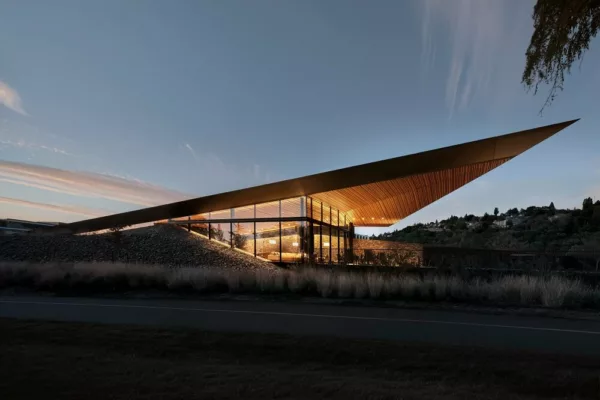
The Prow
The Prow, designed by Aidlin Darling Design, is a dynamic biophilic retreat nestled within Expedia Group’s new 40-acre corporate campus in Seattle.
With its soulful sanctuary and seamless integration with the natural surroundings, this innovative design fosters a tranquil environment for employees, inspiring creativity and innovation away from the day-to-day offices.
The concept’s focus on form and function ensures a harmonious and rejuvenating experience for all who visit this captivating architectural marvel.
2. Mark Cavagnero Associates
– Winner in Architectural Design / Best of Best in Educational Buildings
With a focus on creating inspiring educational spaces, Mark Cavagnero Associates has consistently impressed with their design excellence. Their ability to blend modern aesthetics with functional design has made them a top choice for educational buildings in San Francisco.

San Francisco Conservatory of Music Bowes Center – Urban Vertical Village
The San Francisco Conservatory of Music Ute and William K. Bowes, Jr. Center for Performing Arts, designed by Mark Cavagnero Associates, is a visionary addition to the Civic Center cultural and arts district. As an urban “vertical village,” this dynamic complex ingeniously blends musical education, performance spaces, and public experiences all under one roof.
The jewel-box performance halls, encased in striking glass facades, not only showcase the creativity within but also beckon the public to immerse themselves in world-class performances, making it an architectural gem that enriches the cultural landscape of San Francisco.
3. Marcy Wong Donn Logan Architects & PLAD
– Winner in Architectural Design / Heritage Architecture
Preserving the rich cultural heritage of San Francisco, Marcy Wong Donn Logan Architects & PLAD excels in restoring historic structures. Their dedication to heritage restoration has earned them acclaim and commendation in the architectural community.
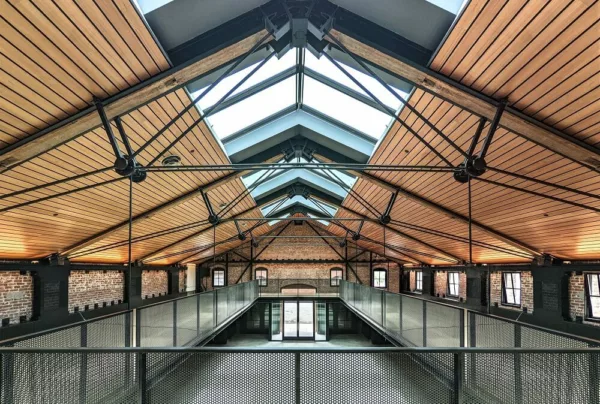
MacLac Building D
The MacLac Building D, a remarkable adaptive reuse project by Marcy Wong Donn Logan Architects & PLAD, stands as a shining example of heritage architecture restoration in San Francisco. Once an occupied historic paint and lacquer factory, this edifice has been expertly transformed while preserving its rich history.
The design incorporates abundant daylight through ridge skylights, skillful architectural lighting to accentuate historic brick walls and perforated metal stairs, and seismic upgrades that pay homage to the original steel trusses. The addition of a structural diaphragm creates a functional and earthquake-resistant space, ensuring this restored gem continues to hold its place in the city’s architectural legacy.
4. Fougeron Architecture
– Winner in Architectural Design / Residential Architecture – Single Family
Fougeron Architecture is renowned for its exceptional single-family residential designs. Their ability to create unique and personalized spaces that cater to the needs of their clients sets them apart in the residential architecture realm.
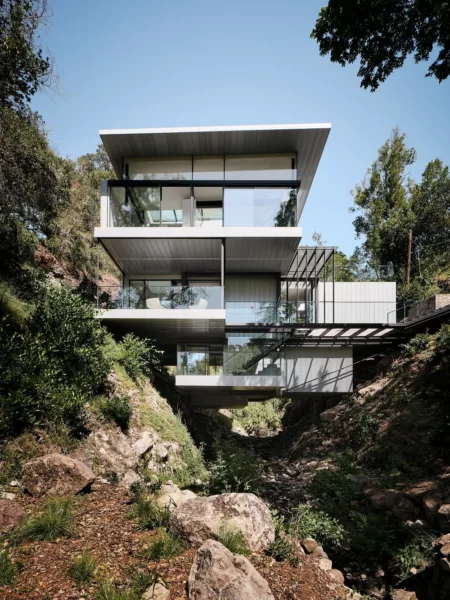
Suspension House
Fougeron Architecture’s Suspension House, winner of the Architectural Design / Residential Architecture – Single Family category, stands as a testament to their expertise in crafting exceptional single-family residential designs. Suspended gracefully between two picturesque California hills, this remodel exemplifies ingenuity and adaptability.
By reusing half of the existing structure and ingeniously inserting a steel frame to anchor the home to the hillsides, the design not only complies with regulations but also creates a seamless connection with nature.
The minimalistic glass volumes embrace the beauty of the surroundings, offering an immersive experience that humbles and harmonizes with the natural environment, elevating this project as an architectural masterpiece in the realm of residential design.
5. EHDD
– Winner in Architectural Design / Restoration & Renovation
EHDD’s expertise lies in restoration and renovation projects that breathe new life into old structures. Their commitment to preserving the historical significance of buildings while infusing them with modern elements has garnered widespread praise.
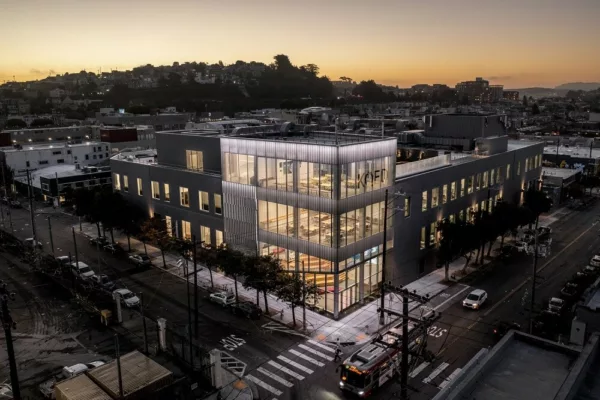
KQED Headquarters
EHDD’s exceptional expertise in restoration and renovation is beautifully showcased in their transformation of KQED’s headquarters into a vibrant hub for civic engagement and contemporary journalism.
This award-winning project seamlessly marries historical preservation with modern design elements, creating an open, bright, and airy 21st-century workplace that fosters collaboration and supports KQED’s mission as a nonprofit, public media station.
The redesign maximizes flexibility, providing spaces for a wide range of events while enhancing visibility to the public, making it a true testament to EHDD’s talent in revitalizing existing structures for the benefit of the community and the future.
6. TOPOS Landscape Architects
– Winner in Architectural Design / Urban Design
As experts in urban design, TOPOS Landscape Architects has transformed public spaces in San Francisco. Their approach to urban renewal has resulted in sustainable and aesthetically pleasing landscapes.
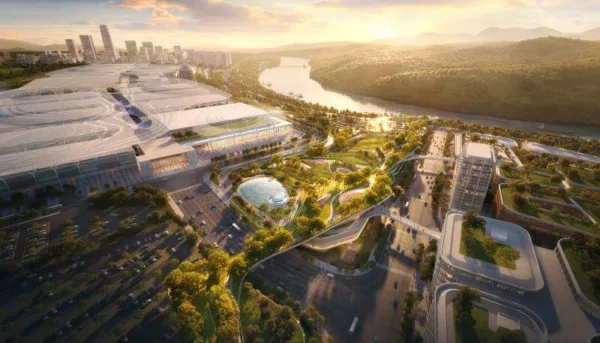
Mountain City Green Chain
TOPOS Landscape Architects’ visionary approach to urban design is brilliantly demonstrated in their Mountain City Green Chain project in Chongqing, China. Faced with the challenges of a fast-growing metropolis and limited open space, this landscape architect-initiated program introduces an unprecedented concept of connected green spaces that create enduring environmental, community, economic, and cultural value.
By strategically harmonizing these realms, Chongqing is positioned towards a sustainable future. The development serves as a multifunctional community resource, inviting people to gather, exercise, and learn about nature, ultimately enriching the city’s urban fabric and enhancing the well-being of its residents.
7. Michael Hennessey Architecture
– Winner in Architectural Design / Residential Architecture – Multi Unit
Michael Hennessey Architecture is renowned for its multifamily residential designs. Their ability to create vibrant and community-oriented living spaces has earned them recognition as one of the top firms in this category.
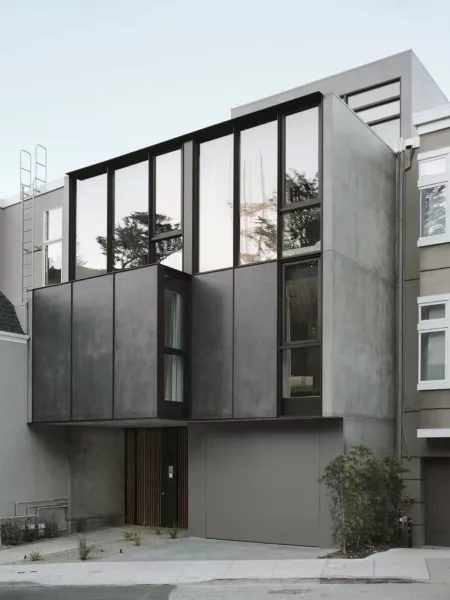
Twin Peaks Residences
Michael Hennessey Architecture’s expertise in multifamily residential designs shines through in their transformative project, Twin Peaks Residences. This remarkable endeavor converts a neglected single-family residence into a dynamic 3-unit residential building, perfectly situated on the eastern slope of Twin Peaks in San Francisco.
The design thoughtfully capitalizes on its location, offering sweeping city views from each of the five floors at the rear of the building. The front elevation, a stunning composition of steel frames with aluminum windows and integrally colored cement plaster, accentuates the building’s contemporary aesthetic.
The interior spaces, adorned with sheer curtains and walnut wood veneer, infuse warmth and variation, creating a harmonious balance with the clean and precise exterior massing. This multifamily residential gem exemplifies Michael Hennessey Architecture’s talent in crafting vibrant and captivating living spaces that foster community and elevate the residential experience in the heart of San Francisco.
8. FUTUREFORMS
– Winner in Architectural Design / Installations & structures
FUTUREFORMS is known for pushing the boundaries of architectural innovation through installations and structures. Their projects often challenge conventional norms and showcase the endless possibilities of architectural design.
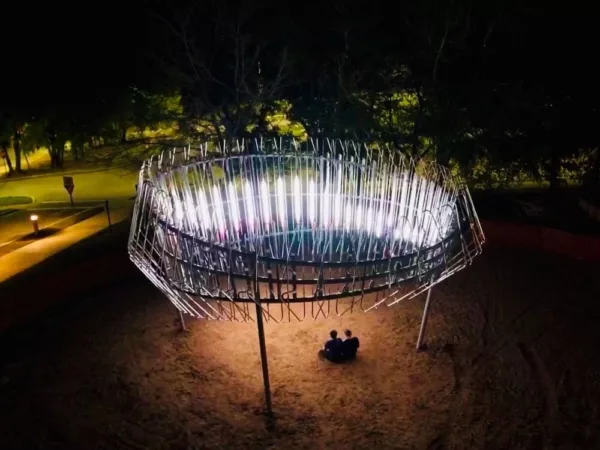
Constellations
Futureforms’ architectural prowess is brilliantly showcased in their award-winning project, Constellations. This dynamic and immersive artwork serves as a captivating theater-in-the-round, transporting viewers into an enchanting world of flowing patterns and ethereal light and shadow formations.
Inspired by early studies of animal locomotion and planetary motion, this visionary piece of art employs geometry, light, and shadow to create a meditative internal space during the day, while transforming into a playful and mesmerizing illuminated sculpture at night.
Constellations continuously evolves, never the same, and always in flux, captivating audiences with its ever-changing beauty. Futureforms’ commitment to pushing the boundaries of architectural innovation is evident in this stunning installation that showcases the endless possibilities of architectural design, creating a unique and unforgettable experience for all who encounter it.
9. Mork Ulnes Architects
– Winner in Architectural Design / Residential Architecture
Mork Ulnes Architects has an impressive portfolio of residential projects that exhibit contemporary design and sustainable solutions. Their commitment to environmental consciousness is evident in every project they undertake.
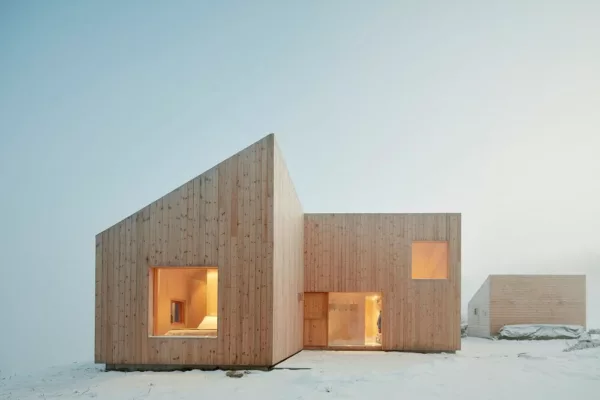
Mylla Hytte
Mork Ulnes Architects’ expertise in residential architecture is beautifully demonstrated in their award-winning project, Mylla Hytte. Situated north of Oslo, this 940 sqft ski cabin pays homage to the rich history and efficient space planning of traditional Norwegian hyttes while infusing contemporary design and sustainable solutions.
The interior is a testament to modernity, boasting a lofty and light-filled ambiance with seamless indoor-outdoor connections that invite nature inside. To adhere to codes requiring a gabled roof, Mylla takes a bold approach, splitting the gable in half, resulting in four independent shed roof volumes arranged in a pinwheel configuration.
This innovative roof geometry not only adds a touch of architectural drama but also efficiently directs snowshed away from two sheltered outdoor spaces framed by the cruciform plan. Mork Ulnes Architects’ commitment to environmental consciousness is evident in every aspect of this project, from its sustainable design choices to its thoughtful incorporation of the surrounding landscapes.
Mylla Hytte stands as a remarkable example of contemporary design harmoniously blending with tradition and nature, making it a truly inspiring residential architectural masterpiece.
10. Fong & Chan Architects
– Winner in Architectural Design / Healthcare Architecture
Fong & Chan Architects excel in creating healthcare spaces that prioritize patient comfort and well-being. Their innovative designs have had a positive impact on the healthcare industry in San Francisco.
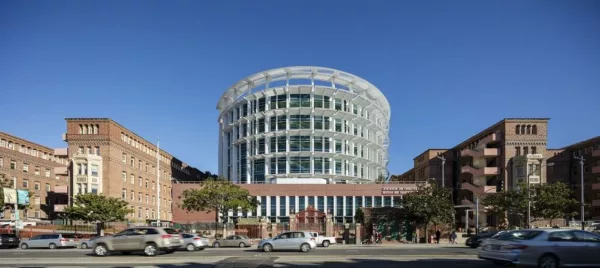
Zuckerberg San Francisco General Hospital & Trauma Center
The exceptional healthcare expertise of Fong & Chan Architects shines in their award-winning project, the Zuckerberg San Francisco General Hospital & Trauma Center (ZSFG). This ambitious project involves the design of a new 284-bed, 9-story, state-of-the-art general acute care hospital that sets a new standard for healthcare architecture in San Francisco.
With a strong emphasis on patient comfort and well-being, the hospital is thoughtfully designed to provide a humanistic and culturally competent healing environment. Fong & Chan Architects’ innovative approach has not only resulted in a visually striking facility but also one that incorporates leading practices of sustainable design, demonstrating their commitment to environmental responsibility.
The hospital’s layout thoughtfully accommodates various departments, including diagnostic and treatment facilities, an emergency trauma center, and auxiliary support and administration areas, ensuring a seamless and efficient workflow for medical staff. This remarkable project has made a significant impact on the healthcare industry in San Francisco, setting the benchmark for future healthcare architectural endeavors in the region.
11. Butler Armsden Architects
– Winner in Architectural Design / Residential Architecture
Butler Armsden Architects are celebrated for their residential architecture projects, which seamlessly blend classic and modern elements. Their unique design philosophy has earned them a reputation as one of the top firms in this category.

Valley of the Moon Retreat
The Valley of the Moon Retreat, designed by the celebrated Butler Armsden Architects, showcases their unmatched expertise in residential architecture. As winners in the Architectural Design category, the firm’s unique approach seamlessly blends classic elements of Mission-Era Spanish haciendas with a modern vocabulary, resulting in an exquisite and contemporary weekend retreat.
Rooted in the dynamic interplay between nature and the built environment, the design blurs the boundaries between the interior and exterior spaces, creating a harmonious fusion that encourages a close connection with nature. A central courtyard spills seamlessly into the surrounding woods, offering an immersive experience that allows residents to feel at one with both architecture and the natural environment.
The retreat embodies the firm’s design philosophy of creating living spaces that provide the perfect balance of comfort, aesthetics, and functionality. Butler Armsden Architects’ ability to harmoniously merge timeless design principles with contemporary sensibilities has earned them a well-deserved reputation as one of the premier firms in the residential architecture domain.
12. IwamotoScott Architecture
– Gold in Architectural Design / Transportation
IwamotoScott Architecture’s transportation projects have set new standards in contemporary architecture in San Francisco. Their ability to combine aesthetics, functionality, and sustainability has earned them a well-deserved Gold award.
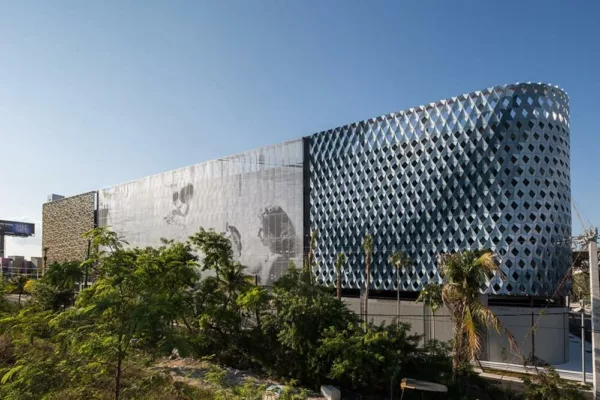
Miami Design District – City View Garage
Seamlessly combining aesthetics, functionality, and sustainability, IwamotoScott’s design philosophy shines through in this remarkable project. Sited along the edge of Miami’s bustling Design District, the garage’s facade serves as a captivating billboard, leaving a lasting impression on passersby.
The main body of the building features a multi-level parking structure above a retail storefront, incorporating a six-story office block. IwamotoScott’s ingenuity is evident in their design approach, which prioritizes natural ventilation, eliminating the need for mechanical systems within the parking structure.
To achieve this, the architects utilized a digitally-fabricated modulated metal screen with varying aperture sizes, allowing for the seamless flow of air while creating a mesmerizing visual effect. The use of a gradient coloration pattern further enhances the dynamic appearance of the metal screen, transforming the facade into an ever-changing, gradated structural skin that interacts with the shifting light throughout the day.
The office facade, thoughtfully designed with a modulated gradient pattern of glass sizes, complements the overall aesthetic ambitions of Miami’s Design District redevelopment. IwamotoScott’s visionary design for the City View Garage stands as a testament to their unmatched ability to push the boundaries of architectural innovation while creating spaces that harmonize with their surroundings and redefine the standards of contemporary transportation architecture.
13. Form4 Architecture
– Bronze in Architectural Design / Commercial Architecture
Form4 Architecture’s commercial designs reflect their pursuit of architectural excellence. Their ability to create dynamic and modern commercial buildings has earned them recognition and accolades.

Oasis: Silicon Valley Technology Center
Form4 Architecture’s Bronze-winning project, Oasis: Silicon Valley Technology Center, showcases their unwavering commitment to architectural excellence in commercial design. This awe-inspiring project stands as an iconic beacon of innovation and design, striking a harmonious balance between majesty and intimacy.
The design narrative weaves together a suspended tropical garden amidst futuristic building systems, a multi-level enclosure, and an abundance of glass, all aimed at leaving a meaningful imprint on the world. Purposefully totemic, Oasis’ imagery is conceived as a testament to technology itself, reflecting Form4 Architecture’s forward-thinking approach. Situated on a tight urban parcel in Santa Clara, California, facing the Great America theme park, this 300,000 square-foot project signifies the inevitable shift towards higher density and transit-oriented developments emerging in Silicon Valley.
Designed as a prototype for the workplace of tomorrow, this 13-story building is supported by a transparent podium housing a sequence of retail experiences that engage with the street level. The design further elevates the user experience as the ground gracefully curls into a canopy, capturing the pedestrian flow and leading to a spacious public cafe.
Notably, a tongue of pushed and pulled earth strategically filters light into the parking garage below. At the 9th floor, the project unveils a special oasis, the Big Sky Garden. This 3-story urban retreat features an open-air café and a grand environment, breathing life into the space and casting visual magnetism for miles.
Aspirational and rewarding, the Big Sky Garden is thoughtfully embedded within the elevated massing, creating an experience that harmoniously connects the building with its surroundings while offering a distinct escape for its occupants. Form4 Architecture’s Oasis exemplifies their ability to create dynamic and modern commercial buildings that captivate the imagination and set new standards for architectural innovation.
14. Mary Barensfeld Architecture
– Bronze in Landscape Architecture / Gardens
Mary Barensfeld Architecture has carved a niche for itself in the landscape architecture realm with their innovative and breathtaking garden designs. Their ability to transform outdoor spaces into captivating retreats is truly commendable.
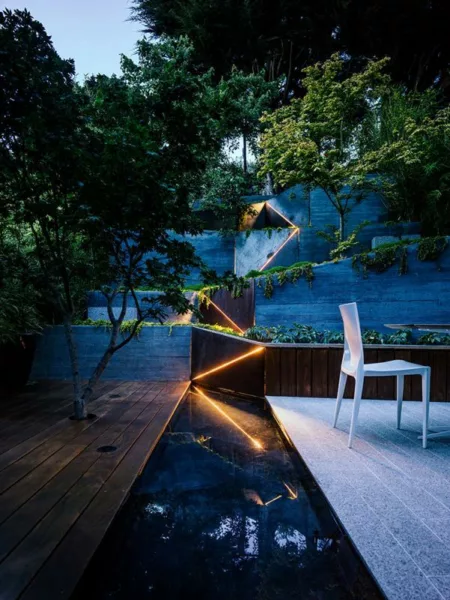
Hilgard Garden
Mary Barensfeld Architecture’s award-winning project, Hilgard Garden, exemplifies their mastery in landscape architecture, where innovation and breathtaking designs converge to create captivating garden spaces. This project seeks to extend the owners’ living space outdoors, crafting a mesmerizing garden room.
The site’s steep slope presented a unique challenge, requiring creative solutions for accessing an upper seating area while navigating significant elevation changes. In a stroke of brilliance, the design eschews a conventional stair that would occupy a substantial portion of the smaller backyard square footage. Instead, a ramping meandering path through aromatic groundcover and the gracefully outstretched limbs of sculptural Japanese maples was chosen as an experiential and visually striking garden path.
Mary Barensfeld Architecture’s approach transforms the landscape into a sanctuary that invites exploration and contemplation, where every step reveals a new angle or perspective. The integration of aromatic groundcover and the poetic presence of Japanese maples engage the senses, creating a multi-layered experience that heightens the connection between visitors and nature.
Hilgard Garden stands as a testament to Mary Barensfeld Architecture’s dedication to crafting innovative and harmonious outdoor spaces, earning them well-deserved recognition in the realm of landscape architecture. Their ability to transform outdoor spaces into captivating retreats is a true testament to their design prowess and creativity.
Top Architecture Firms in San Francisco shaping architectural landscapes in city and beyond
The architecture firms mentioned above are just a glimpse of the diverse and talented architectural community in San Francisco. Their award-winning architecture projects showcase their expertise, innovation, and dedication to sustainable and aesthetically pleasing designs.
Whether it’s commercial marvels, urban renewal, or heritage restoration, these firms have made a significant impact on the city’s architectural landscape. As San Francisco continues to evolve, these top architecture firms will undoubtedly play a vital role in shaping the city’s future.
When it comes to architectural marvels, Boston stands tall as a city that seamlessly blends historical charm with contemporary innovation. This article takes you on a journey through the architectural landscape, showcasing the top eight architecture firms headquartered in Boston that have shaped landscapes around the world with their award-winning designs. From high-rise buildings to green architecture and heritage restoration, these architectural innovators from Boston have left an indelible mark on landscapes globally.
Top Architecture Firms in Boston
1. Touloukian Touloukian Inc.
– Winner in Architectural Design / High Rise Buildings

Touloukian Touloukian Inc. has redefined the concept of vertical living in Boston with their expertise in high-rise buildings. Their designs go beyond mere skyscrapers; they are soaring symbols of modernity and elegance. Each high-rise created by Touloukian Touloukian Inc. complements the city’s skyline, standing as a testament to their architectural prowess and innovation.
333 Tremont Street – Redefining Sustainable Vertical Living
Firm Location: Boston, United States
Company: Touloukian Touloukian Inc.
Lead Architect: Theodore Touloukian
The image showcases the breathtaking masterpiece, 333 Tremont Street, an architectural marvel brought to life by Touloukian Touloukian Inc. This twenty-one story NetZero Energy / Net Zero Water tower is nestled in the vibrant Bay Village neighborhood of Boston. As a beacon of modernity and elegance, the tower stands tall as an iconic symbol of sustainable living.
The project’s design is a testament to the firm’s innovative thinking and commitment to sustainable urban development. Located in the immediate vicinity of public open space, the tower seamlessly blends with its surroundings while offering a futuristic vision for vertical living. A distinctive building opening allows natural light to flood the site, creating an eco-conscious and energy-efficient environment.
One of the most striking features of 333 Tremont Street is the extension of one of the park’s alleys into an elevated public plaza. This thoughtful design approach not only enhances urban aesthetics but also minimizes the impact of urban density on neighboring structures. The result is an architectural gem that harmonizes with the cityscape, rather than imposing upon it.
The building’s mixed-use nature further enhances its functionality, creating spaces that cater to a diverse range of needs within the community.
333 Tremont Street stands as a trailblazer, setting new standards for sustainable architecture in Boston. It showcases how architectural innovation can shape the city’s skyline while prioritizing environmental consciousness and the well-being of its occupants. As a masterpiece in vertical living, this tower is a reflection of Touloukian Touloukian Inc.’s commitment to pushing the boundaries of modern design and redefining the future of urban living.
+ Winner in Architectural Design / Commercial Architecture
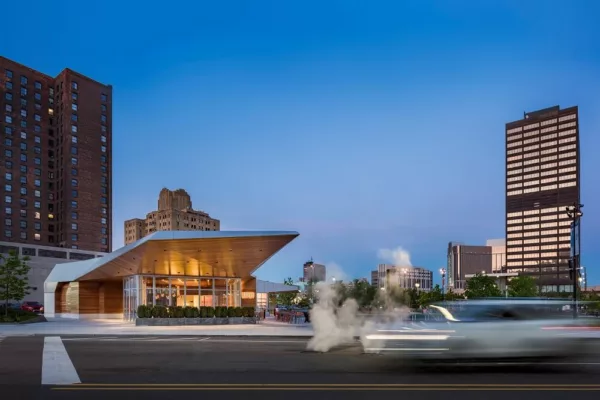
In addition to their expertise in high-rise buildings, Touloukian Touloukian Inc. has excelled in commercial architecture, leaving a lasting impact on Boston’s business landscape. Their commercial designs effortlessly marry aesthetics with functionality, creating spaces that inspire productivity and collaboration. Through their projects, Touloukian Touloukian Inc. has shaped the city’s commercial districts, contributing to its economic growth.
Lumen at Beacon Park – Illuminating the Heart of Downtown Detroit
Prize: Winner in Architectural Design / Commercial Architecture
Firm Location: Boston, United States
Company: Touloukian Touloukian Inc
Lead Architect: Theodore Touloukian
As a shining example of Touloukian Touloukian Inc.’s prowess in commercial architecture, Lumen at Beacon Park graces the vibrant streets of downtown Detroit. Situated along Grand River Avenue, this urban revitalization project stands as a testament to the firm’s commitment to shaping urban spaces that inspire and invigorate the community.
Central to Lumen’s design is its modern geometry, featuring strong cantilevered roof forms that pay homage to the historic G.A.R. building and the park’s elliptical lawn. The project’s grand stairway leads visitors to a captivating roof deck, thoughtfully aligned with the iconic historic Book Tower Building. The result is an interplay of historical context and contemporary architecture that elevates the project’s visual appeal and significance.
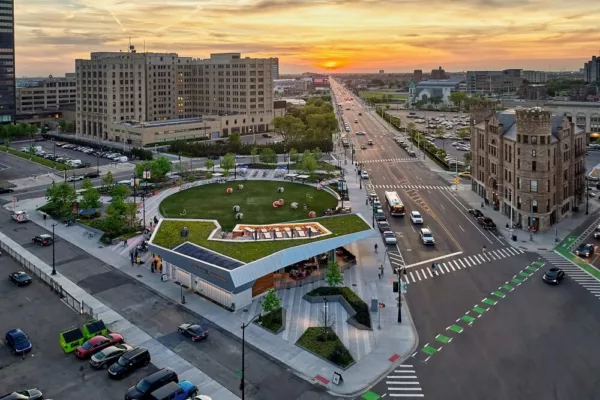
Lumen at Beacon Park was envisioned not only as a commercial space but also as a catalyst for economic development in the surrounding neighborhood. It serves as an anchor for the emerging area, drawing in visitors, businesses, and residents alike, injecting newfound life into the district.
The project’s collaborative design team, including Lumen Detroit as the restaurant owner, livingLAB as the landscape architect, and Studio NYL as the structural engineer, among others, worked seamlessly with Touloukian Touloukian Inc. to bring this vision to life. Their collective effort has resulted in a harmonious space that fosters a sense of community and collaboration.
Beyond its architectural significance, Lumen at Beacon Park is committed to sustainability and environmental consciousness. LEED consultant Resilient Buildings Group ensured that the project adhered to the highest standards of green design, further contributing to the city’s eco-conscious efforts.
Lumen at Beacon Park stands tall as a shining beacon of urban regeneration, breathing new life into downtown Detroit. Its architectural brilliance and functional design have left an indelible mark on the city’s commercial landscape, setting new standards for future developments. As a winner in commercial architecture, this project showcases Touloukian Touloukian Inc.’s ability to create spaces that not only inspire productivity but also enrich the urban fabric and elevate the human experience.
2. Kennedy & Violich Architecture
– Winner in Architectural Design / Green Architecture
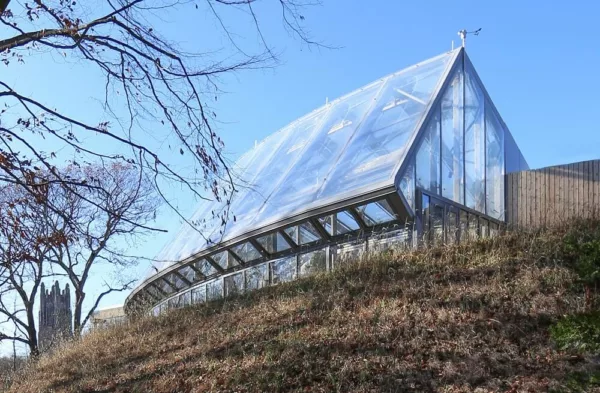
Green architecture is a hallmark of sustainable urban living, and Kennedy & Violich Architecture have taken the lead in implementing eco-friendly design concepts throughout Boston. Their award-winning designs seamlessly integrate nature and the built environment, creating spaces that promote harmony between humans and nature. Kennedy & Violich Architecture’s commitment to green architecture has made them a driving force in Boston’s sustainable development.
Global Flora Conservatory – A Sustainable Greenhouse Redefining Nature’s Connection
Firm Location: Boston, United States
Project Location: Wellesley, Massachusetts,
USA Company: Kennedy & Violich Architecture
Lead Architects: Sheila Kennedy, FAIA & Frano Violich, FAIA
In the pursuit of sustainable urban living, Kennedy & Violich Architecture unveils their award-winning masterpiece, the Global Flora Conservatory. Situated on the grounds of Wellesley College, this architectural marvel transcends the traditional greenhouse concept, reimagining it as a hub for interdisciplinary education and public immersion in nature.
At the core of the conservatory’s design is its commitment to eco-friendly principles and seamless integration with nature. The curved form of the building follows the arc of the sun, maximizing solar irradiance and minimizing energy consumption. By thoughtfully accommodating the varying heights of trees from the dry biome to the wet biome, the conservatory’s interior becomes a dynamic space that harmoniously reflects the site’s natural landscape.
The Global Flora Conservatory is not merely a structure to house Wellesley College’s plant collection; it is a living testament to the profound connection between humans and nature. The topography of living soils serves as a foundation for flexible public programs, allowing the space to transform into pop-up research labs, informal classrooms, and areas for reading, relaxation, and performances. Visitors are invited to immerse themselves in the diverse flora and experience the wonder of the natural world.
As an architectural celebration of sustainable living, the conservatory sets new standards for green architecture. Through their innovative design and strategic collaboration with consulting partners, Kennedy & Violich Architecture has created a space that goes beyond passive observation of nature; it fosters active engagement and appreciation for the environment.
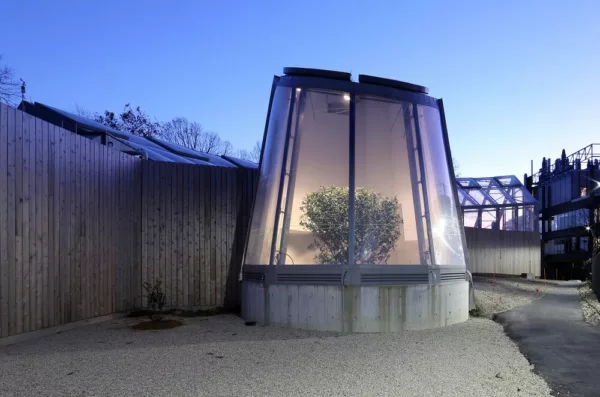
The Global Flora Conservatory stands as a powerful symbol of Boston’s commitment to sustainable development, with Kennedy & Violich Architecture leading the way as a driving force in the city’s eco-conscious initiatives.
It is an invitation to the community to rediscover their connection with nature, offering a sanctuary where education and environmental awareness flourish in harmony. This remarkable project exemplifies Kennedy & Violich Architecture’s dedication to creating spaces that not only inspire but also resonate with the deepest essence of the human-nature relationship.
3. NADAAA
– Winner in Architectural Design / Best of Best in Residential Architecture – Single Family
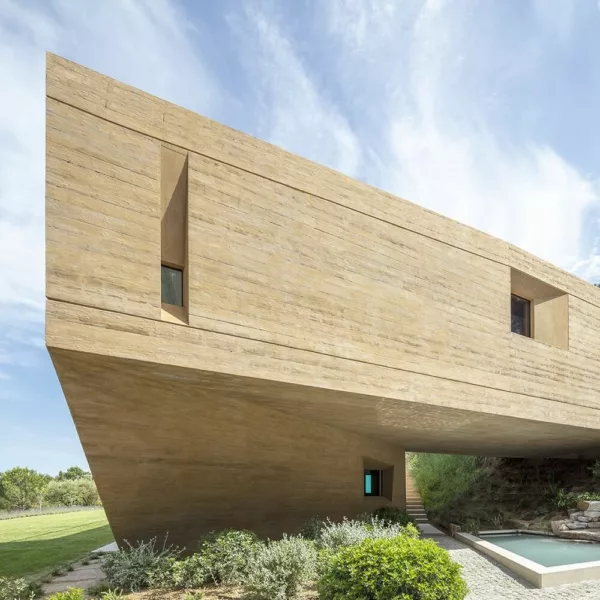
NADAAA’s residential architectural designs in Boston have earned them accolades, including the prestigious “Best of Best” award in single-family home design. Their projects are a blend of creativity and functionality, redefining modern living spaces. NADAAA has skillfully captured the essence of luxury, crafting bespoke homes that perfectly embody their clients’ visions and aspirations.
Villa Varoise – A Harmonious Fusion of Nature and Luxury Living
Firm Location: Boston, United States
Company: NADAAA
Lead Architect: Nader Tehrani
NADAAA’s remarkable expertise in residential architecture has reached new heights with the awe-inspiring Villa Varoise. As the recipient of the prestigious “Best of Best” award in single-family home design, this project exemplifies the perfect union of creativity and functionality, elevating modern living spaces to unparalleled heights.
Villa Varoise stands as a testament to NADAAA’s dedication to crafting bespoke homes that capture the essence of luxury and perfectly embody their clients’ visions and aspirations. The project’s design team, including Architecte Associé and Interiors: BIDARD & RAISSI, worked harmoniously to curate an architectural masterpiece that transcends traditional design conventions.
The heart of Villa Varoise lies in its enclosed courtyard, skillfully integrated into the site’s sloping terrain to create a seamless connection between interior and exterior spaces. The slipped court, a result of landscape integration, introduces a captivating play of light and shadow, amplifying the sense of tranquility and cultivating a serene environment.
One of the most striking features of Villa Varoise is the monumental vaulted threshold that beckons visitors into the central courtyard. This ruled surface serves as a dynamic mediator between the geometry of the supporting stair, the pool, and the living areas above. The result is a spatial composition that exudes both grandeur and intimacy, a reflection of NADAAA’s architectural finesse.
Villa Varoise gracefully harmonizes with its surrounding landscape, transforming the site into a living canvas where nature and luxury living converge. Nader Tehrani’s visionary leadership as the lead architect is evident in every detail, showcasing an unparalleled level of craftsmanship and design innovation.
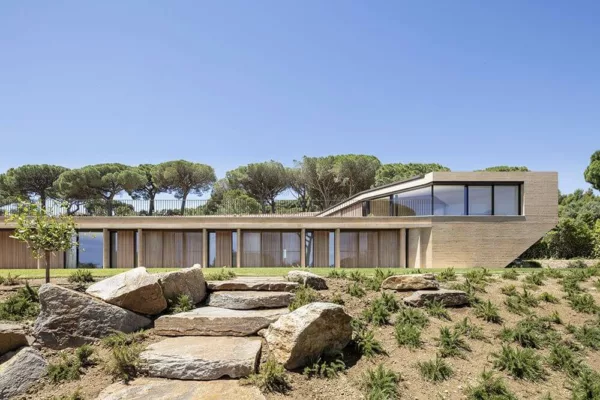
As a residential architectural gem, Villa Varoise has redefined modern living in Boston, setting a new standard for single-family home design. Its flawless synthesis of creative vision, functionality, and sustainable systems stands as a testament to NADAAA’s position as a trailblazer in the industry. Villa Varoise epitomizes the art of living, where architecture and nature unite to create an exquisite living experience that transcends the boundaries of time and space.
4. Klopfer Martin Design Group
– Winner in Architectural Design / Public
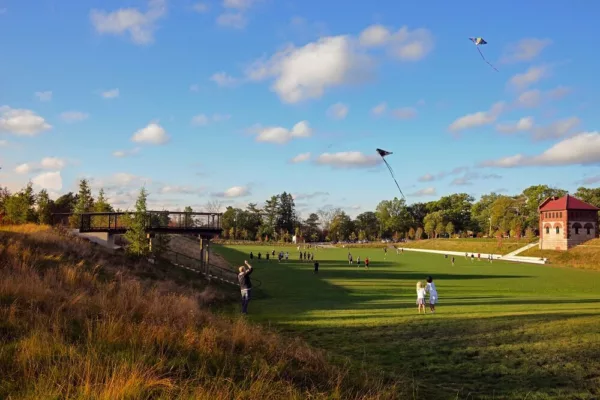
Public spaces play a vital role in urban life, and Klopfer Martin Design Group understands this better than anyone else. Their award-winning public architectural designs in Boston have transformed parks, plazas, and cultural centers into dynamic and inviting places. With an emphasis on community engagement, their designs have revitalized public spaces, creating environments that foster social interactions and cultural appreciation.
Fisher Hill Reservoir Park – Reviving History as a Vibrant Cultural Artifact
Prize: Winner in Landscape Architecture / Public
Firm Location: Boston, United States
Company: Klopfer Martin Design Group
Klopfer Martin Design Group’s visionary approach to public architecture comes to life in the breathtaking Fisher Hill Reservoir Park. As an award-winning project in landscape architecture, this 10-acre reservoir park stands as a testament to the firm’s commitment to transforming public spaces into dynamic and culturally significant places.
Inspired by the historical significance of public infrastructure in America’s urban centers during the 1800s, Fisher Hill Reservoir Park celebrates its past as a cherished cultural artifact. The park’s design thoughtfully integrates topographic markers indicating the waterline, inviting visitors to experience the sensation of “plunging” into the former watersheet. This nostalgic journey through history connects visitors to the park’s heritage, fostering a sense of connection with the past.
An exquisite carved granite map of the water supply system further enriches the park, providing context and illustrating the intricacies of water resources delivery. This artistic element serves as a beautiful homage to the park’s historical significance, encouraging visitors to appreciate the delicate balance between urban development and nature’s bounties.
Fisher Hill Reservoir Park redefines the concept of public spaces, offering fully accessible pathways that weave through artful play elements, prospect points, and thoughtfully curated plantings. This masterful design creates a harmonious balance between form and function, imbuing the park with a sense of scale, seasonal interest, and a rich botanical future.
The park’s transformation into a vibrant cultural hub is a testament to Klopfer Martin Design Group’s commitment to community engagement. By revitalizing this reservoir into a dynamic and inviting public space, the firm has enriched the lives of the local community, fostering social interactions, and nurturing a deep appreciation for culture and heritage.

Fisher Hill Reservoir Park stands as a living canvas of architectural brilliance, where history and modernity intertwine. It serves as a testament to Klopfer Martin Design Group’s exceptional ability to breathe new life into public spaces, creating environments that resonate with the past while embracing a dynamic and sustainable future. The park’s transformation into a cherished cultural artifact is a true reflection of the firm’s unwavering commitment to elevating urban life through thoughtful and innovative design.
5. Elkus Manfredi Architects
– Winner in Architectural Design / Restoration & Renovation
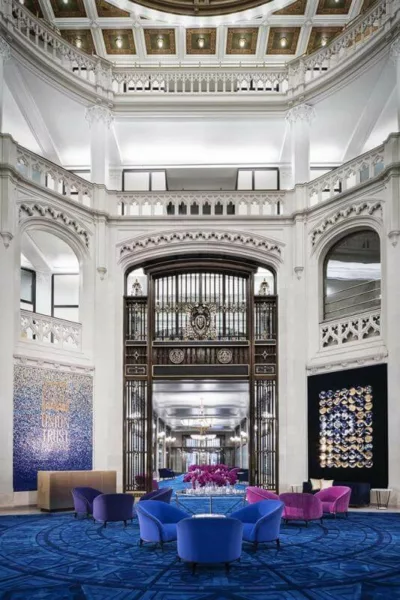
Preserving Boston’s architectural heritage is a responsibility that Elkus Manfredi Architects takes seriously. Their restoration and renovation projects have breathed new life into historic buildings, ensuring that they continue to stand as timeless landmarks. With a delicate balance between modern interventions and historical significance, Elkus Manfredi Architects has earned recognition as architectural custodians.
Union Trust Building – A Resplendent Revival of Pittsburgh’s Historic Jewel
Prize: Winner in Architectural Design / Restoration & Renovation
Firm Location: Boston, United States
Company: Elkus Manfredi Architects
Lead Architect: Howard F Elkus, FAIA
The Union Trust Building, a magnificent 667,000-square-foot structure dating back to 1918, holds the heart of downtown Pittsburgh, Pennsylvania. In the hands of Elkus Manfredi Architects, this historic jewel has undergone a resplendent revival, becoming a shining example of architectural restoration and renovation.
The building’s revitalization became a mission to reimagine its potential in contemporary Pittsburgh life. The client’s vision was clear – to restore the Union Trust Building to its former glory while creating a vibrant destination that attracts exciting retail and restaurant tenants. Additionally, the goal was to offer flexible, modern Class-A office space, making it a prime location for innovation start-ups and traditional office tenants alike.
The transformation began with a delicate balance between honoring the building’s storied past and infusing it with modern functionalities. The ground-floor lobby, thoughtfully restored and respected in its original historic grandeur, serves as a dramatic and welcoming entry and meeting space for the offices above. The atrium, an architectural gem in its own right, was transformed into a grand arrival space adorned with a stunning carpet pattern that mirrors the design of the Tiffany dome above.
As one ascends through the nine open levels, the carpet changes color, a graceful gradation from blue on the ground floor to gold/amber on the top floor.
Elkus Manfredi Architects also commissioned thirty pieces of original art for the building, many of which pay homage to Pittsburgh and the Union Trust Building itself. These art installations celebrate the city’s cultural heritage and infuse the space with a sense of pride and identity.
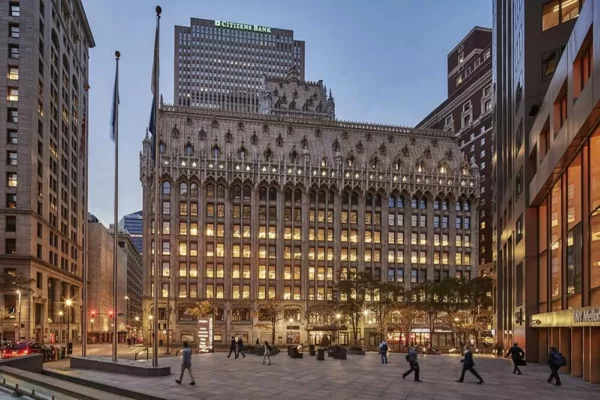
The Union Trust Building stands as a timeless testament to the mastery of architectural restoration and renovation by Elkus Manfredi Architects. Its revival has breathed new life into a once-neglected landmark, securing its place as a cherished architectural jewel in Pittsburgh’s downtown landscape.
As custodians of architectural heritage, Elkus Manfredi Architects has achieved remarkable success in preserving the building’s historic legacy while redefining its future as a bustling hub of commerce, culture, and community. The Union Trust Building exemplifies the firm’s commitment to honoring the past while embracing innovation, ensuring that the building will continue to stand tall as a symbol of Pittsburgh’s enduring legacy.
6. Machado Silvetti
– Winner in Architectural Design / Heritage Architecture
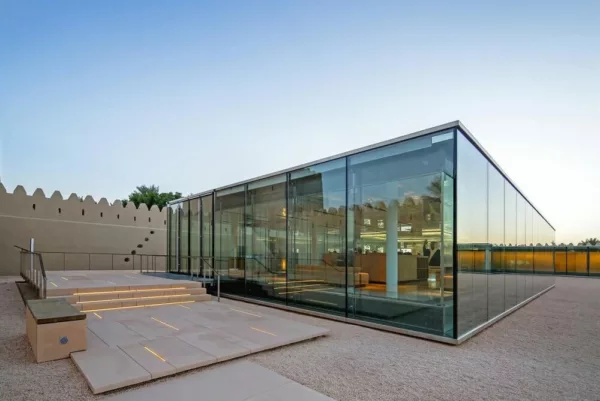
Machado Silvetti’s expertise in heritage architecture shines through their award-winning projects in Boston. Their designs not only preserve the city’s cultural heritage but also revitalize historical sites for contemporary use. Machado Silvetti’s commitment to maintaining the essence of the past while embracing the future has garnered them admiration from architectural enthusiasts worldwide.
Qasr al Muwaiji – A Timeless Marvel of Heritage Architecture
Prize: Winner in Architectural Design / Heritage Architecture
Firm Location: Boston, United States
Company: Machado Silvetti
Lead Architect: Jorge Silvetti
Machado Silvetti’s mastery in heritage architecture comes to life in the awe-inspiring project, Qasr al Muwaiji. This historic fort and its grounds, nestled within the city of Al Ain, have been carefully restored and revitalized into an exhibition facility and cultural monument. As an award-winning project in heritage architecture, Qasr al Muwaiji stands as a timeless marvel that preserves the essence of the past while embracing the future.
Originally intended as a means of defense for the surrounding oasis, the fort holds profound archaeological and historical significance. It is not only a cherished cultural artifact but also the birthplace of the UAE President, Khalifa Bin Zayed al Nahyan. Machado Silvetti’s commitment to preserving and honoring this heritage shines through every aspect of the project.
The primary design challenge of Qasr al Muwaiji was achieving a delicate balance between preserving the fort’s unique character and archaeological remains while introducing a new building within its empty court. The architectural team approached this challenge with utmost sensitivity, ensuring that the pavilion and programs blend seamlessly with the site, minimizing their physical and visual impact.
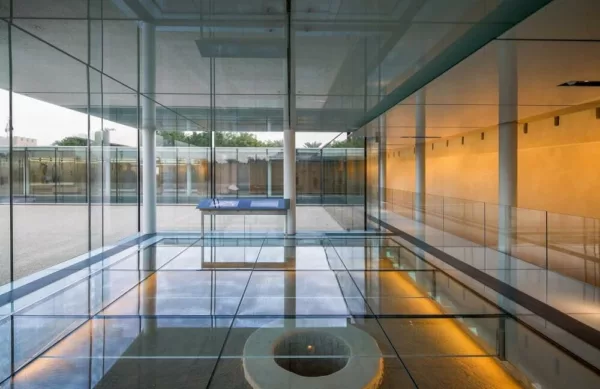
The Pavilion itself is a masterpiece of minimal expression, rendered with glass volumes raised slightly above the ground-plane to create a sense of lightness and reverence for its historical host. The architecture’s rhetoric beautifully communicates that the building appears to truly float, paying homage to the delicate historical context.
Preserving the archeological remains of the site was a paramount consideration in the project’s execution. To achieve this, the foundation’s depth was limited to twenty centimeters, ingeniously resting the building on the ground using a concrete raft and cantilevered steel columns. This innovative approach not only respects the site’s archaeological integrity but also adds to the pavilion’s aesthetic allure.
Qasr al Muwaiji stands as an exemplar of Machado Silvetti’s profound commitment to heritage architecture, illustrating their capacity to breathe new life into historical sites while preserving their authentic soul. The project has garnered admiration from architectural enthusiasts worldwide, praising its seamless integration of past and present, and its profound contribution to preserving cultural heritage for generations to come.
As a timeless marvel of heritage architecture, Qasr al Muwaiji stands tall as a testament to the enduring legacy of history and the vision of architectural excellence by Machado Silvetti.
7. Mikyoung Kim Design
– Winner in Landscape Architecture / Commercial
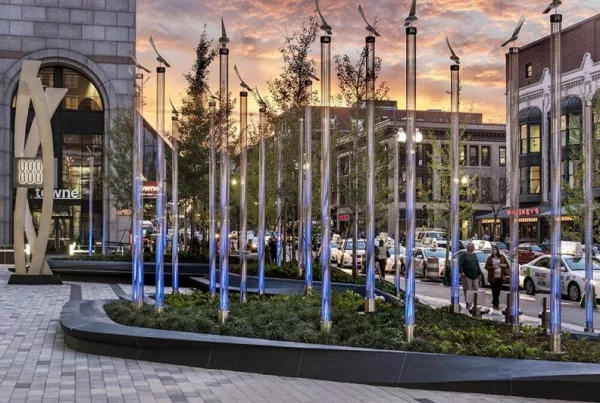
Mikyoung Kim Design has elevated commercial landscapes in Boston, reimagining urban spaces as inviting sanctuaries. Their award-winning commercial landscape designs integrate nature and artistry, providing people with environments that soothe the senses and stimulate creativity. Through their projects, Mikyoung Kim Design has emphasized the value of green spaces in promoting well-being and urban harmony.
The Prudential Center at 888 Boylston Street – Where Sustainability Meets Urban Harmony
Prize: Winner in Landscape Architecture / Commercial
Firm Location: Boston, United States
Company: Mikyoung Kim Design
Lead Architect: Mikyoung Kim
Mikyoung Kim Design’s transformative touch is beautifully showcased in the award-winning project, The Prudential Center at 888 Boylston Street. Located in the historic Back Bay neighborhood of Boston, this sustainably designed civic space stands as a shining example of elevating commercial landscapes to new heights.
Inspired by the natural climatic systems that move through the site, The Prudential Center is a sanctuary where artistry meets sustainability. This iconic landmark is credited as one of the most sustainable office buildings in New England, anticipating LEED platinum certification. Embracing the value of green spaces in promoting well-being, the design seamlessly integrates a series of green roofs, rain gardens, wind turbines, and solar panels, not only contributing to a healthier urban environment but also powering and irrigating the landscape.
The brilliance of The Prudential Plaza lies in its innovative portrayal of wind patterns through mesmerizing landscape elements. The “wind-swept” carved granite planters and a grove of forty color-changing steel light columns adorned with sculptural wind vanes respond gracefully to the flow of the wind. Each “light vane” becomes a living wind map, celebrating the dynamic forces of nature within the bustling urban realm.
Beyond its captivating beauty, The Prudential Center serves as a hub of vibrant civic life. The plaza, designed in harmony with the new 888 Boylston Street mixed-use tower, bestows a unique identity and character to the Prudential Retail Arcade and the Eataly Market entry. It has quickly become the epicenter for civic events, retail, dining, and programmed concerts, enriching downtown Boston’s cultural and social fabric.
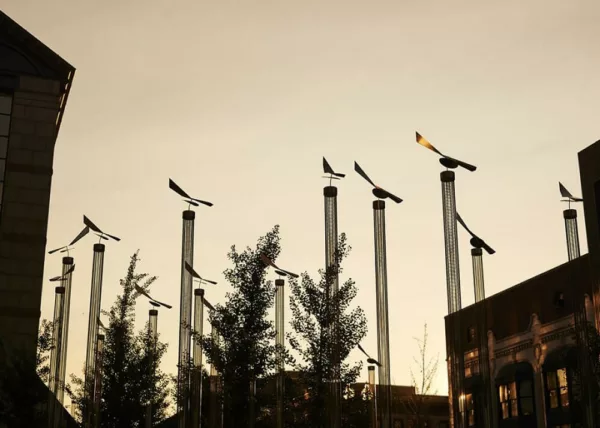
Mikyoung Kim Design’s visionary leadership, helmed by Mikyoung Kim, has breathed new life into this urban oasis, reimagining commercial spaces as inviting sanctuaries. The Prudential Center exemplifies the firm’s commitment to merging nature’s soothing embrace with artistic ingenuity, fostering environments that inspire creativity and nurture well-being.
As a testament to the powerful union of sustainability and urban harmony, The Prudential Center stands as a timeless masterpiece that transcends the boundaries of commercial landscape design. It has become an inspiring symbol of the positive impact landscape architecture can have on communities, nurturing a sense of connection to nature and celebrating the artistry of design in the heart of the city.
8. Howeler + Yoon
– Bronze in Architectural Design / Other Architecture
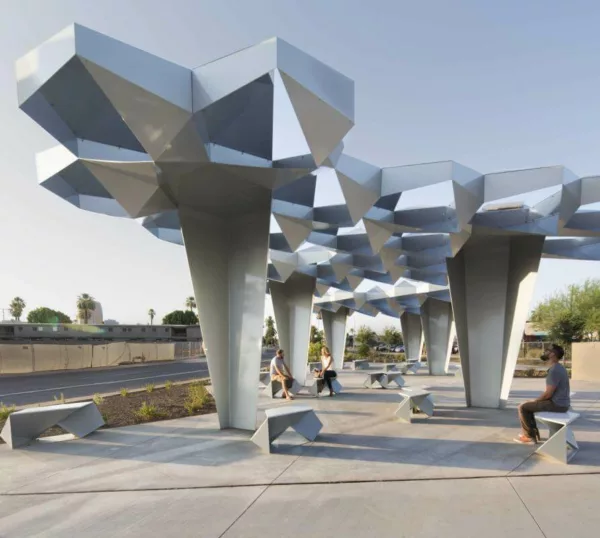
Howeler + Yoon’s pursuit of unconventional architectural designs has earned them the Bronze award in the category of “Other Architecture.” Their projects challenge traditional norms, pushing the boundaries of what architecture can be. By exploring uncharted territories and embracing experimentation, Howeler + Yoon have demonstrated that innovation knows no bounds.
Shadow Play – Where Innovation Casts a Mesmerizing Urban Canopy
Prize: Bronze in Architectural Design / Other Architecture
Firm Location: Boston, United States
Company: Howeler + Yoon
Lead Architect: Meejin Yoon
Shadow Play, the ingenious project by Howeler + Yoon, is a breathtaking transformation of a traffic median into a captivating public space that redefines the downtown Phoenix streetscape at Roosevelt Row. As a Bronze award recipient in the category of “Other Architecture,” this unconventional creation stands as a testament to the firm’s unwavering commitment to pushing the boundaries of traditional design norms.
At the heart of Shadow Play lies an audacious vision to foster pedestrian life and reimagine urban spaces on an urban scale. Clusters of exquisitely designed shade structures intertwine to create a striking public parasol, offering respite from the intense desert sun. This remarkable canopy, formed from an aggregation of identical geometric modules crafted from steel plates, exudes both structural rigor and artistic finesse.
The genius of the design lies in its delicate interplay of light and shadow. The folded steel cells ingeniously filter the intense sunlight, casting mesmerizing shadows on the ground and giving rise to localized micro-climates within the shade. The canopy’s geometry is meticulously calibrated to maximize the production of shade and shadow while allowing for gentle breezes and invigorating air movement.
Embracing sustainability as an integral part of innovation, Shadow Play is adorned with photovoltaic panels mounted on the canopy’s top surface. These solar panels harness the intense and direct sunlight, converting it into renewable energy stored in batteries. The illuminated canopy, glowing from within during the evening, becomes a mesmerizing beacon of urban artistry, enlivening the cityscape with its luminous presence.
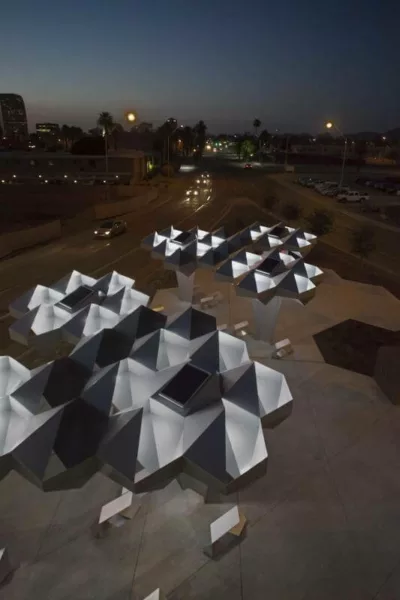
Shadow Play emerges as a bold urban platform, boldly reclaiming under-utilized public space and transforming it into a site-specific collective haven within downtown Phoenix. Howeler + Yoon’s creation foregrounds its environment, fostering a vibrant and inclusive public gathering place that celebrates the intersection of art, architecture, and innovation.
As a Bronze award-winning project in “Other Architecture,” Shadow Play stands as a testament to Howeler + Yoon’s fearless spirit of experimentation and their indomitable passion for reimagining the urban fabric. This innovative creation serves as an inspiring reminder that architectural innovation knows no bounds, and that the pursuit of visionary designs can transform even the most mundane spaces into awe-inspiring urban oases.
Innovative Top Architecture Firms in Boston – Pioneering a Visionary Legacy
The top architecture firms in Boston have undoubtedly left an indelible mark on the city’s skyline and culture. Through their award-winning designs, they have transformed Boston into a living testament to architectural excellence and innovation.
Each firm’s unique style and approach have contributed to the diverse tapestry of architectural wonders that define this historic city. As Boston continues to evolve, these architectural innovators will undoubtedly shape its future and inspire generations to come.
Welcome to the City of Angels, where architectural marvels stand tall and proud, courtesy of the Top Architecture Firms in Los Angeles. In this article, we delve into the innovative works of Los Angeles-based award-winning architecture firms that have left an indelible mark on the city’s skyline and beyond. From eco-friendly and sustainable architecture to culturally significant landmarks, these firms have redefined the essence of design in Los Angeles and around the world.
Top Architecture Firms in Los Angeles – Showcasing Excellence in Design
1. Lorcan O’Herlihy Architects (LOHA)
– Winner in Architectural Design / Workplaces
Eco-friendly, Sustainable Architecture, Design Innovations
Lorcan O’Herlihy Architects (LOHA) tops our list with their groundbreaking achievements in eco-friendly and sustainable architecture. Their transformative workplaces are a testament to design innovations that emphasize energy efficiency and occupant well-being. LOHA’s designs maintain harmony with nature, bringing a sustainable touch to Los Angeles’ urban landscape.

Nike Icon Studios LA
Lorcan O’Herlihy Architects (LOHA) once again demonstrates their prowess in sustainable and innovative design with Nike Icon Studios LA. As the flagship studio for Nike’s Global Brand Imaging operations, the space seamlessly blends art and science to facilitate a diverse range of photography and imaging capacities.
LOHA’s brilliant design repurposes an existing 42,000 sq ft linear, prefabricated core and shell building, maximizing its potential for an entirely efficient, in-house photography process. Nike Icon Studios LA is a true testament to LOHA’s commitment to creating environmentally responsible and cutting-edge architectural solutions.
2. Swa
– Winner in Architectural Design / Public
Social Impact, Green Architecture, Urban Regeneration
Swa emerges as a force for positive social change, crafting green architectural wonders that contribute to urban regeneration. Their public projects breathe new life into the city’s spaces, promoting sustainability and fostering social interaction. Swa’s architecture creates vibrant communities that embody the spirit of Los Angeles.
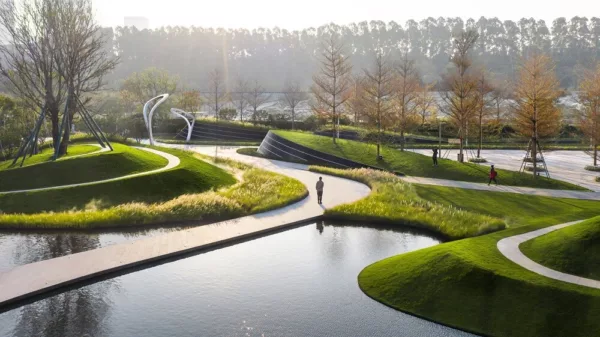
Panyu Central Park
Swa, known for their positive social impact and green architecture, collaborates with a visionary team to craft Panyu Central Park. Breaking the boundaries of a private gated community, this ambitious project promotes social sharing of open space, offering a respite from the bustling urban life of Guangzhou.
The park’s pedestrian-centric design and thoughtfully designed trail system establish vital connections between the central business district, a preserved forest, and each residential block, encouraging an active lifestyle and providing enjoyable car-free commuting options for the vibrant community it embraces.
Swa’s commitment to urban regeneration shines through in this transformative project that harmoniously blends with its surroundings, fostering a sense of togetherness and creating a green sanctuary amid the cityscape.
3. Hatch Colasuonno + Relativity Architects (HCRA)
– Winner in Architectural Design / Social Housing
Social Impact, Sustainable Architecture, Adaptive Reuse
HCRA stands out for their unwavering commitment to social impact, exemplified by their exceptional social housing projects. They redefine sustainable architecture and employ adaptive reuse techniques to address the pressing need for affordable housing in Los Angeles. HCRA creates thriving communities that uplift residents and redefine urban living.
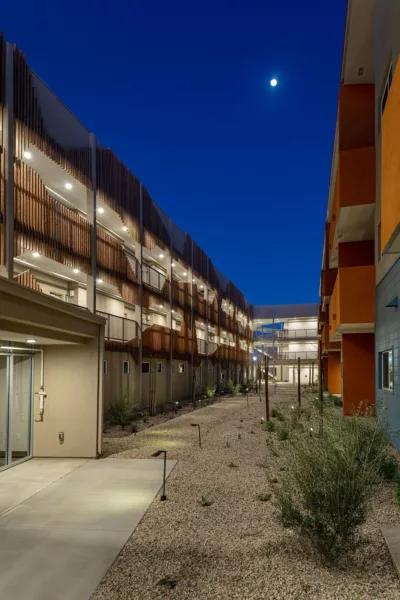
Imagine Village
Hatch Colasuonno + Relativity Architects (HCRA), renowned for their dedication to social impact and sustainable architecture, extends their expertise to Imagine Village. This affordable housing community, featuring 75 units for veterans and families, showcases their commitment to uplifting communities and redefining urban living.
With thoughtful architectural solutions, HCRA successfully addresses the challenge of housing two distinct resident types safely and sensitively. In response to the desert climate, a groundbreaking approach to shading the south facade using thermal wood demonstrates their innovative design practices.
As part of a larger complex, Imagine Village strikes a perfect balance between density, open space, and joyful colors, capturing the essence of its desert home and creating a thriving community for its residents.
4. Arshia Architects
– Winner in Architectural Design / Residential
Design Innovations, Sustainable Architecture, Adaptive Reuse
Arshia Architects takes residential design to new heights, integrating design innovations with sustainable practices. Their residential projects blend seamlessly with the city’s fabric, showcasing a harmonious living experience. With a focus on adaptive reuse, Arshia Architects preserves Los Angeles’ architectural heritage while promoting eco-conscious living.
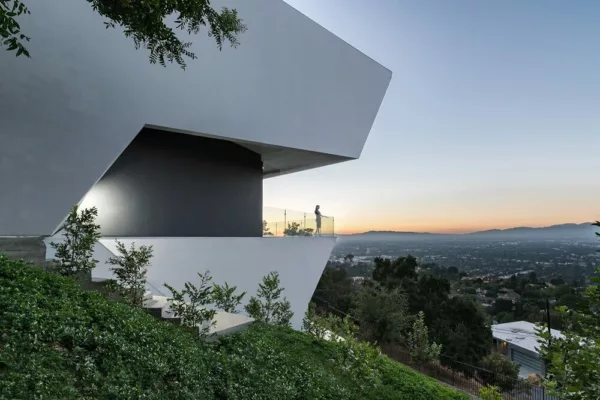
MU77
Arshia Architects’ ingenious approach to residential design shines through in MU77, a stunning house perched on the cusp of a fold in the Hollywood hills. Embracing design innovations and sustainable practices, this residence seamlessly integrates with the steep hillside, creating a harmonious living experience that engages in a captivating dialogue with the surrounding landscape.
Despite the strenuous challenges posed by planning and building regulations, Arshia Architects masterfully pushes the boundaries, resulting in a striking architectural masterpiece that elegantly navigates height and viewshed restrictions, leaving a lasting impression on its entry facade.
MU77 showcases the firm’s dedication to preserving Los Angeles’ architectural heritage through adaptive reuse while promoting eco-conscious living in the heart of the Hollywood hills.
5. CO Architects
– Winner in Architectural Design / Educational Buildings
Cutting-Edge, Green Architecture, Architectural Excellence
CO Architects secures a prominent spot for their cutting-edge designs in educational buildings. Their projects exemplify green architecture, creating innovative learning environments that foster creativity and collaboration. The firm’s commitment to architectural excellence drives their mission to transform educational spaces for future generations.
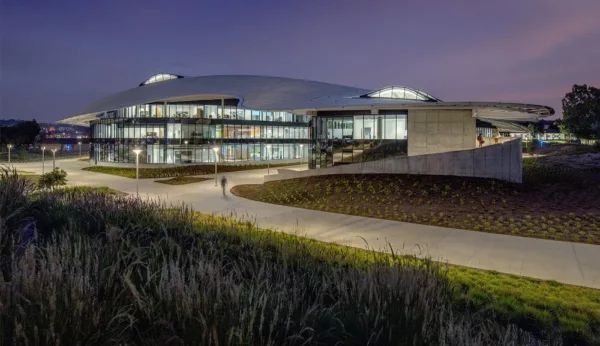
Student Services Building at Cal Poly Pomona
CO Architects’ commitment to cutting-edge design and green architecture is evident in the exceptional Student Services Building at Cal Poly Pomona.
This award-winning project exemplifies architectural excellence, providing vital accessibility to administrative services while creating innovative learning environments that foster creativity and collaboration. Nestled within its context, the building’s undulating roof beautifully integrates with the surrounding mountains, while thoughtful design elements, such as generous overhangs and north-facing roof protrusions, flood the interior with natural daylight.
The landscape, thoughtfully mounded around the base, forms a harmonious connection with the ground, enveloping a pedestrian breezeway sheltered by the roof. Workspaces and offices invite ample daylight and stunning views, facilitating seamless inter-departmental collaboration. CO Architects’ transformative vision brings a new era of educational excellence to Cal Poly Pomona, providing future generations with a dynamic and sustainable learning environment.
6. Archillusion Design
– Winner in Architectural Design / Hospitality Architecture
Design Innovations, Iconic Landmarks, Sustainable Architecture
Archillusion Design redefines hospitality architecture with their iconic landmarks that leave an indelible impression. Their design innovations elevate the guest experience while showcasing a harmonious blend of luxury and eco-friendliness. Sustainability remains at the core of their hospitality projects, epitomizing responsible luxury.

CasaPlutonia Resort
Archillusion Design’s exceptional expertise in hospitality architecture shines through in the award-winning CasaPlutonia Resort. This architecturally innovative retreat redefines traditional concepts, inviting guests to immerse themselves in a sanctuary that fosters synergy among spirit, nature, and high design.
CasaPlutonia’s mesmerizing Euclidean Platonic geometries enhance the desert’s planar dimensions, offering guests a unique opportunity to rejuvenate their well-being, discover their creative muse, and draw inspiration from breathtaking desert sunsets and the majestic solitude of a Joshua Tree.
Archillusion Design’s commitment to design innovations and sustainable practices transforms CasaPlutonia Resort into an iconic landmark, harmoniously blending luxury with eco-friendliness, epitomizing responsible luxury for a memorable and transformative guest experience.
7. XTEN Architecture – Winner in Architectural Design / Institutional Architecture
Innovative Design Studios, Sustainable Architecture, Cultural Heritage
XTEN Architecture masterfully incorporates cultural heritage into contemporary designs. Their innovative design studios embrace modern aesthetics while paying homage to the city’s diverse history. Sustainability remains paramount in their approach, positioning XTEN as a frontrunner in environmentally responsible institutional architecture.
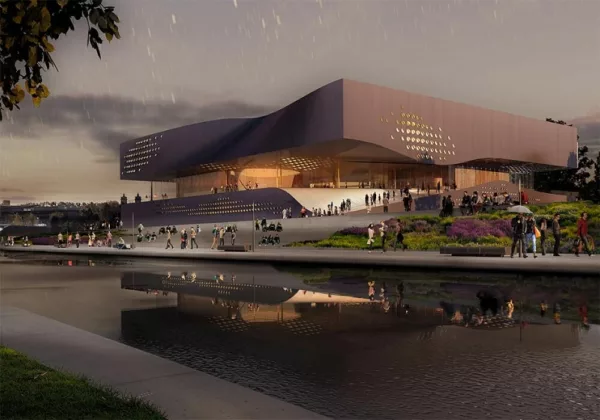
Science Island
XTEN Architecture’s exceptional expertise in institutional architecture is brilliantly showcased in the award-winning Science Island project. Their profound understanding of cultural heritage is evident in this contemporary design that seamlessly integrates with Kaunas’ diverse history. As an emblem of the progressive city, Science Island speaks to its natural and built surroundings, harmoniously connecting with Nemanus island, Neman River, Naujamiestis, and the historic Old Town.
Inspired by the typology of the Mat-building, this science museum features a 3-story 72.5m square structure punctuated by three primary voids, flooding the interior with natural light. XTEN’s innovative approach creates a new open public space that harmoniously blends with the park, forming a transformative destination that blurs the lines between a cultural institution and a public gathering spot.
Sustainability remains at the forefront of XTEN’s design, solidifying their position as trailblazers in environmentally responsible institutional architecture, making Science Island a beacon of progress and cultural heritage in Kaunas, Lithuania.
8. Griffin Enright Architects – Silver in Architectural Design / Cultural Architecture
Cultural Heritage, Adaptive Reuse, Sustainable Architecture
Griffin Enright Architects’ adaptive reuse projects breathe new life into cultural heritage sites, preserving the city’s rich history. Their commitment to sustainable architecture aligns with their dedication to preserving cultural landmarks. The firm’s silver-winning designs stand as a testament to their deep appreciation for the city’s heritage.
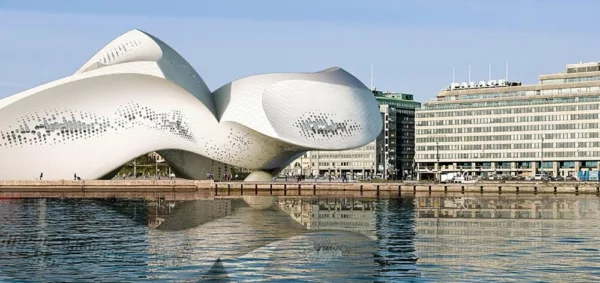
Guggenheim Helsinki
Griffin Enright Architects’ silver-winning Guggenheim Helsinki proposal is a stunning testament to their dedication to preserving cultural heritage and creating transformative spaces. This visionary museum design creates a harmonious relationship between art and the city, breathing new life into the urban fabric. Hovering above the ground, the museum becomes an iconic figure that changes dynamically when viewed from various perspectives – the city, the park, the street, or the water.
The design thoughtfully integrates with its surroundings, framing captivating views of the harbor and reconnecting the city with the water through an activated urban frontage.
Griffin Enright Architects’ innovative approach to adaptive reuse is evident in this proposal, where a new urban space and art park emerge at the edge of the Gulf of Finland. The design features an inner street leading to a courtyard and covered plaza, parallel to a renewed pedestrian path along the water’s edge, forging essential connections between the museum, the city, and the park.
Sustainability remains at the heart of the design, resonating with their commitment to preserving the city’s cultural landmarks. The Helsinki Guggenheim becomes a waterfront oasis, inviting visitors to a vibrant space adorned with public amenities, cafes, a design store, a black box theater, and an outdoor amphitheater, creating a new living room for both the museum and the city.
Transforming the South Harbor into an unexpected and dynamic nexus for Helsinki.
Top Architecture Firms in Los Angeles – Shaping a Sustainable Future
The Top Architecture Firms in Los Angeles have transformed the city’s skyline with their cutting-edge designs and sustainable architecture. From eco-friendly workplaces to adaptive reuse projects, these award-winning architects have demonstrated their commitment to social impact, cultural heritage, and environmentally responsible design.
Their innovative solutions and iconic landmarks have left an indelible mark on Los Angeles, inspiring future generations of designers and urban planners. As the city continues to evolve, these firms will undoubtedly play a pivotal role in shaping a sustainable and culturally rich future for Los Angeles.
As a hub of innovation and architectural marvels, New York City boasts an array of exceptional architecture firms that have made their mark on the city’s skyline and beyond. Discover the Best Architecture Firms in New York: Explore the exceptional firms that have shaped New York City’s skyline and beyond, showcasing their notable projects and contributions to the field of architecture. From breathtaking public spaces to transformative cultural and institutional designs, these firms have made a lasting impact on the city’s built environment.
The Famous Architecture Firm in New York
New York City has witnessed the rise of numerous influential architecture firms, but one that stands out as a pioneer in the industry is Obra Architects. Renowned for their expertise in creating captivating public spaces, Obra Architects has consistently pushed the boundaries of architectural design. Their innovative approach and attention to detail have earned them recognition and acclaim.
The No. 1 Architectural Firm in the World
While New York City boasts exceptional architectural firms, it is important to acknowledge the global landscape. When it comes to the No. 1 architectural firm in the world, the title goes to none other than Gensler. With a remarkable portfolio of projects spanning commercial architecture, Gensler has consistently delivered groundbreaking designs that have revolutionized the industry. Their commitment to pushing boundaries and delivering exceptional spaces has solidified their position as a global leader.
The Best Architectural Firm in the US
In the United States, the architectural landscape is highly competitive, with several firms vying for the top spot. One firm that has consistently garnered praise and recognition is SHoP Architects. Known for their expertise in institutional architecture, SHoP Architects has redefined the way we perceive and interact with public spaces. Their innovative designs and sustainable practices have set new standards for architectural excellence.
Exploring the Best Architecture Firms in New York
Now, let’s delve into the list of the 24 best architecture firms based in New York, United States. These firms have been selected based on their outstanding contributions to various architectural domains, including public spaces, cultural architecture, high-rise buildings, institutional architecture, mixed-use architecture, recreational architecture, residential architecture, exhibition design, restoration and renovation, and more.
24 Best Architecture Firms in New York City, United States
1. Obra Architects – Winner in Architectural Design / Public Spaces
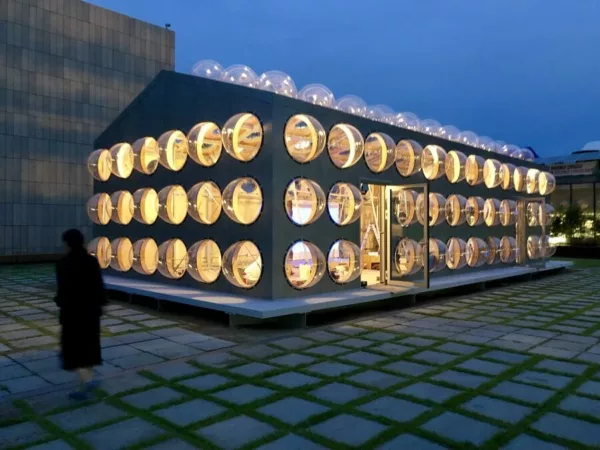
Perpetual Spring, The Climate-Correcting Machine, designed by Obra Architects, is a groundbreaking project located in New York, United States. The client, Museum of Modern and Contemporary Art Seoul (MMCA), commissioned this innovative installation for the exhibition Architecture and Heritage: Unearthing Future.
Perpetual Spring aims to challenge the way cities are reproduced and expanded by providing a space for free public expression. It serves as a platform for awareness and an invitation to action in response to climate change. The project offers a sanctuary during severe weather conditions, creating a comfortable environment for various public activities. It features an open-access venue on the museum grounds, accommodating lectures, poetry readings, theater performances, music events, discussion groups, and book club sessions.
2. MQ Architecture – Winner in Architectural Design / Cultural Architecture
Magazzino Italian Art Museum, designed by MQ Architecture, is a remarkable project located in Cold Spring, New York, United States. Conceived by Nancy Olnick and Giorgio Spanu as a private initiative to showcase their collection of postwar Italian Art, the museum underwent a full renovation of an existing 11,000 square-foot building, with an additional 14,000 square feet of new construction.
The design approach centered on transforming the existing L-shaped building into a rectangular shape, creating a central courtyard. This allowed for the proposal of an independent structure parallel to the longer part of the existing building, fostering a harmonious dialogue between the new and existing elements.
3. Laguarda.Low Architects – Winner in Architectural Design / High Rise Buildings
The Chengdu Co-Innovation and Cooperation Center, designed by Laguarda.Low Architects, is a captivating project located in Chengdu, China. Led by lead architect Pablo Laguarda, the design team, based in New York, crafted a stunning composition that breaks free from the rigid urban grid of the neighboring district.
The project features a mesmerizing spiral form with multiple layers, creating an intriguing visual experience. The ascending and descending halves of the spiral elegantly dance around the block, enveloping the site with undulating and sensuous forms. The two opposing crescents delicately float, akin to Koi fish gliding through a pond. Within this captivating design, an elliptical oasis emerges, forming an urban garden that contrasts the surrounding high-rise towers. This whimsical nod to the orthogonal grid in which it resides showcases the project’s unique and artistic approach.
4. Marble Fairbanks Architects – Winner in Architectural Design / Institutional Architecture
The Greenpoint Library and Environmental Education Center, designed by Marble Fairbanks Architects, is a remarkable project located in New York, United States. This community-centric library serves as a hub for environmental awareness, activism, and education, resulting from the active engagement between the Brooklyn Public Library (BPL) and the local community.
The library doubles the size of the previous building, providing expanded indoor and outdoor spaces for environmental exploration and everyday library use. It encompasses reading rooms and collections tailored for children, teens, and adults, offering a diverse range of resources. The space also accommodates large community events, fostering a sense of togetherness and shared experiences. The exterior includes beautifully landscaped areas designed for teaching and learning, connecting visitors with nature.
5. Fogarty Finger – Winner in Architectural Design / Mixed Use Architecture
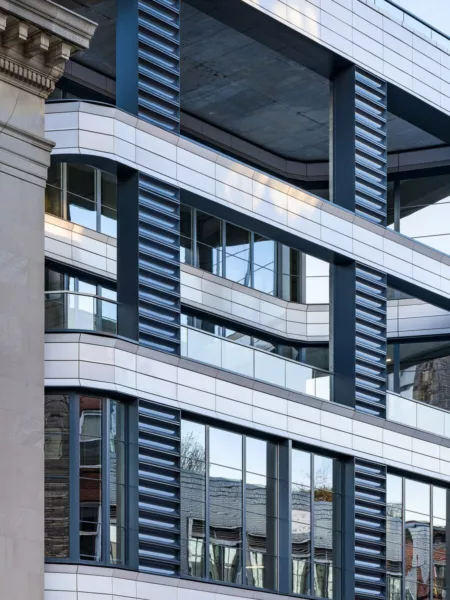
The Dime, designed by Fogarty Finger, is an impressive project located in New York. This new 23-story tower seamlessly merges retail, commercial, and 179 multifamily residential units, situated at the base of the Williamsburg Bridge and adjacent to the existing landmarked Dime Savings Bank.
The façade of The Dime features a visually captivating plaid network composed of tactile, white terra cotta panels with dark horizontal insets. This unique design element adds depth and texture to the building’s exterior, creating a striking visual presence. The soft and curvilinear form of the tower allows for generous natural light to flood the interior spaces and offers unobstructed panoramic views of all five boroughs of New York City.
The Dime is not only a residential tower but also provides a range of amenities for its residents. The building houses an amenity floor that includes a full-service gym, business and residential lounges, and an outdoor roof deck garden. These well-designed spaces offer opportunities for relaxation, recreation, and community engagement.
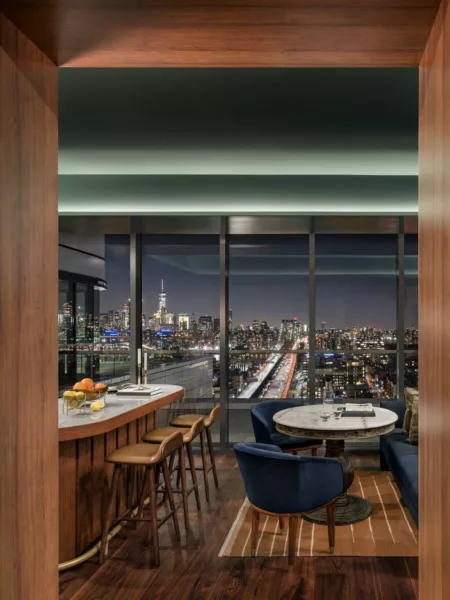
6. Sage and Coombe Architects – Winner in Architectural Design / Recreational Architecture
The Live Oak Bank Pavilion, designed by Sage and Coombe Architects, is a transformative project located in Wilmington, North Carolina. Situated on the site of a former lumber yard mill, cargo weigh station, and brownfield, the Live Oak Bank Pavilion has revitalized the area into a vibrant 6.6-acre waterfront park.
In response to a democratic referendum in 2012, which called for the development of a public park instead of a privately-owned baseball stadium, Sage and Coombe Architects, in close collaboration with landscape architect Hargreaves Jones, created a dynamic outdoor stage and music venue. The pavilion features a 7,200-person capacity and boasts a 4,000 square foot stage, along with back-of-house support buildings.
The Live Oak Bank Pavilion has become a centerpiece of the Riverfront Park, providing a venue for cultural events, performances, and community gatherings.
7. Desai Chia Architecture – Winner in Architectural Design / Residential Architecture – Single Family
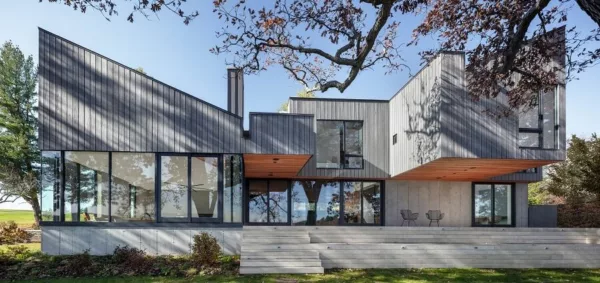
The Copake Lake House, designed by Desai Chia Architecture PC, is a stunning project located in Copake Lake, New York. Led by lead architects Katherine Chia and Arjun Desai, the design team carefully crafted a residence that seamlessly integrates with its lakefront setting.
The architecture of the Copake Lake House consists of a series of framed volumetric compositions and meticulous material details, strategically capturing breathtaking views of the water. Cantilevered program elements create a fluid connection between indoor and outdoor social spaces while also providing shading for the outdoor seating areas below.
The sunken living room, with its panoramic lake views, evokes a sense of being nestled within the water itself. By cleverly stepping down the living room towards the lake, the adjacent dining area enjoys unobstructed views as well. The ceiling overhead features crisscrossed structural wood members that resemble a canopy of tree branches, creating a unique and inviting ambiance.
8. SKOLNICK Architecture + Design Partnership – Winner in Architectural Design / Restoration & Renovation
The Church, designed by SKOLNICK Architecture + Design Partnership, is an extraordinary adaptive reuse and restoration project located in New York. Led by lead architect Lee Skolnick, the firm transformed a once-shuttered religious structure into a vibrant creative center, returning it to the community in a new and inspiring form.
The reimagined facility of The Church offers an array of features and amenities that cater to artistic endeavors. It includes an artists-in-residence program with on-site accommodations, flexible making spaces, exhibition galleries, a resource library, and a public garden. The design promotes interconnection between all levels, facilitated by a glass elevator and minimal steel and wood stairways, enhancing the flow and accessibility of the space.
One of the captivating design elements of The Church is the modern interpretation of stained glass. Portraits of notable East End artists, skillfully painted by the client Eric Fischl, adorn the windows, creating a dynamic and artistic ambiance throughout the building. This unique integration of art and architecture adds a layer of creativity and visual interest to the space.
9. Steven Holl Architects – Winner in Architectural Design / Best of Best in Cultural Architecture

The Nancy and Rich Kinder Museum Building, designed by Steven Holl Architects, is a remarkable project located at the Museum of Fine Arts Houston. Led by renowned architect Steven Holl, the firm has created a horizontal extension of the landscape that unifies the entire MFAH campus, providing open and inviting public spaces.
The Kinder Museum Building features an inviting and porous ground floor, punctuated by seven gardens that seamlessly blend with the surrounding environment. The galleries are strategically arranged around an open forum, providing a dynamic space for the exhibition of art and vertical circulation. Drawing inspiration from cloud circles, concave curves shape the roof geometry, allowing natural light to delicately penetrate the interiors with precision and quality.
Innovative design elements include a translucent glass-tube facade, which not only rejects Houston’s heat but also creates a captivating visual contrast to the adjacent buildings clad in glass, steel, and stone. The Kinder Museum Building’s unique facade both complements and stands out from its surroundings, adding a distinctive character to the campus.
10. Gabellini Sheppard Associates – Winner in Architectural Design / Best of Best in Retail
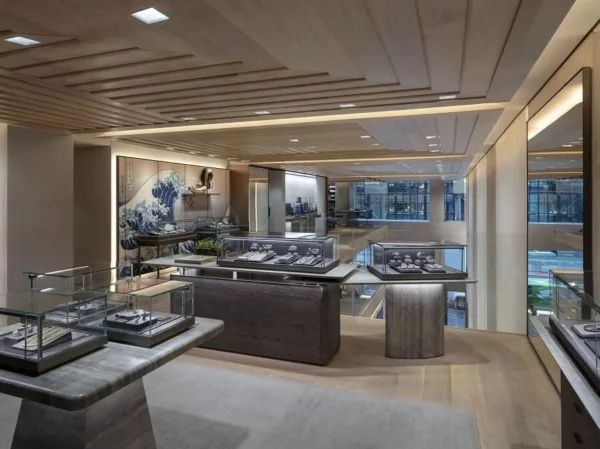
The David Yurman Flagship, designed by Gabellini Sheppard Associates, is a remarkable project located on the prestigious retail corridor of 57th Street and Fifth Avenue in Manhattan, New York. This flagship store boasts a captivating façade, featuring a rose-gold cross framed by fluted granite and limestone proscenium, creating a distinct threshold that transports visitors from the vibrant street scene into the tranquil world of David Yurman.
Upon entering, visitors are greeted by a magnificent triple-height atrium, where the floors gradually step back, reminiscent of the mezzanines found in theaters. This thoughtful spatial arrangement emphasizes movement, materials, and light, culminating in an immersive and intimate boutique experience within a grand flagship setting. The design pays meticulous attention to detail, offering a sophisticated and personal environment for customers to engage with David Yurman’s exquisite jewelry and accessories.
The David Yurman Flagship represents the seamless fusion of architectural excellence and retail experience. Gabellini Sheppard Associates has created a harmonious space that balances grandeur with intimacy, providing visitors with a unique and memorable encounter at the intersection of artistry and luxury.
11. SHoP Architects – Winner in Architectural Design / Institutional Architecture
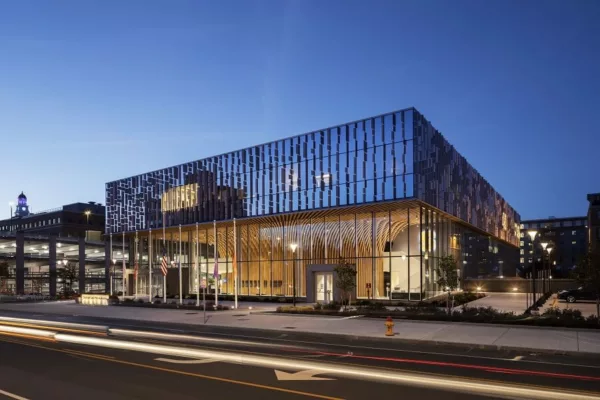
The National Veterans Resource Center at Syracuse University, designed by SHoP Architects, is a groundbreaking project located in New York. This facility is the first of its kind in higher education, designed to serve as a hub that connects generations, communities, and diverse groups on campus.
The NVRC is a testament to Syracuse University’s commitment to supporting military veterans and their families. It provides innovative programming and resources to cater to the needs of over 40,000 veterans. The thoughtfully designed facility offers a range of meeting spaces, social areas, and classrooms, fostering a sense of community and creating an environment conducive to ongoing education, advancement, and respect for the nation’s veterans.
SHoP Architects has masterfully designed the NVRC to seamlessly integrate into the campus landscape while symbolizing the university’s dedication to supporting and honoring veterans. This visionary project not only serves as a practical resource center but also contributes to the academic and cultural life of the university.
12. Valerie Schweitzer Architects – Winner in Architectural Design / Best of Best in Installations & Structures
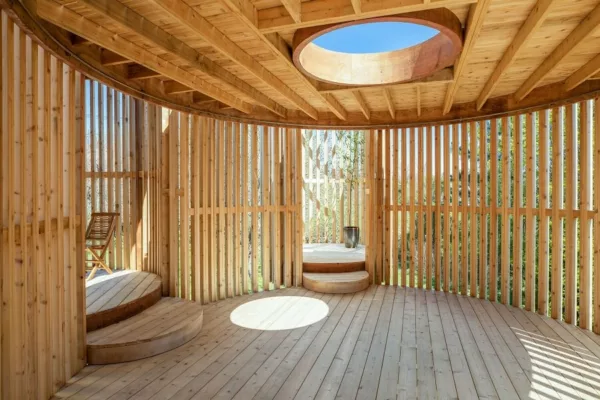
The Outside-In Pavilion, designed by Valerie Schweitzer Architects, is a captivating project located in Watermill, New York. Under the leadership of lead architect Valerie Schweitzer, this pavilion embraces the concept of reconnecting with nature and celebrates the beauty of the surrounding environment.
Situated in the front yard of a Long Island cabin, the pavilion takes inspiration from a forest setting. It features wood posts of ascending heights, reminiscent of tree trunks, and cedar rings that create a sense of organic growth. Salvaged cedar is incorporated into both the flooring and ceilings, adding warmth and texture to the space. Steel posts provide structural support for cantilevered pods and a central area designed for work or relaxation.
One of the distinguishing elements of the Outside-In Pavilion is the gradient wood screen, which blurs the boundaries between man-made space and the natural world. This screen imparts a constant fluidity and connection, allowing occupants to feel immersed in their surroundings. A skylight enhances the experience by providing ever-changing dynamic views of the sky and surroundings. The unadorned cedar material allows its natural beauty to shine, creating a sense of harmony with the environment.
13. CetraRuddy Architecture – Winner in Architectural Design / Tall Buildings
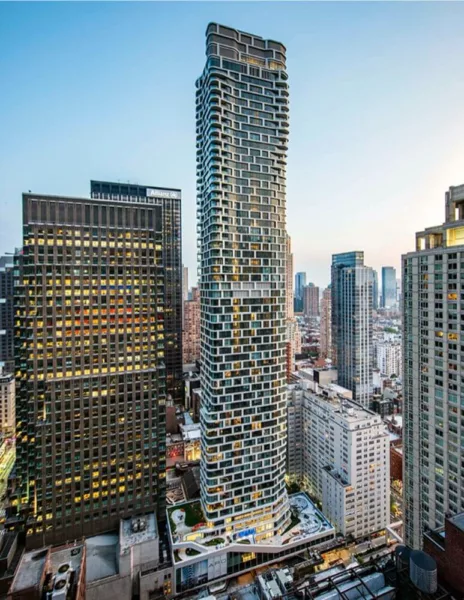
ARO, designed by CetraRuddy Architecture, is an impressive project located in Midtown West, New York. Led by lead architect John Cetra, the firm has carefully considered the surrounding context to create a contemporary urban living environment.
Standing tall at 62 stories, ARO showcases a thoughtful approach to massing that maximizes floor area, outdoor access, and views within the constraints of the site and zoning regulations. The design of ARO is a testament to the ingenuity and expertise of the architects, as they address complex programmatic and structural challenges while maintaining a visually striking presence.
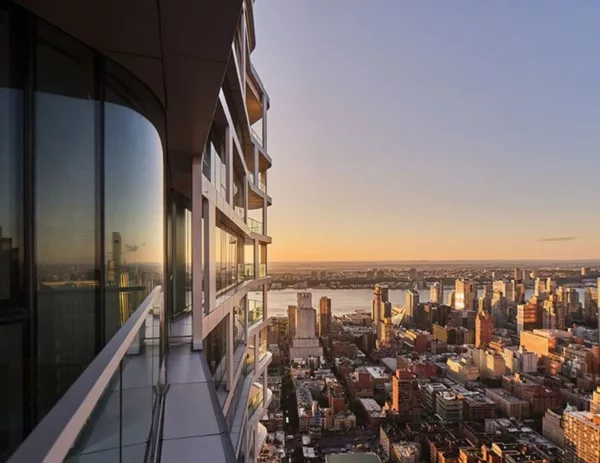
The building’s envelope, though deceptively simple, features a singular graphic that emphasizes the shifts in the building’s form. This design choice not only adds visual interest but also highlights the architectural response to the unique requirements of the project. ARO’s façade serves as a macro-level expression of the building’s complexity and the creative solutions employed.
14. Pei Cobb Freed & Partners with CambridgeSeven – Winner in Architectural Design / Tall Buildings
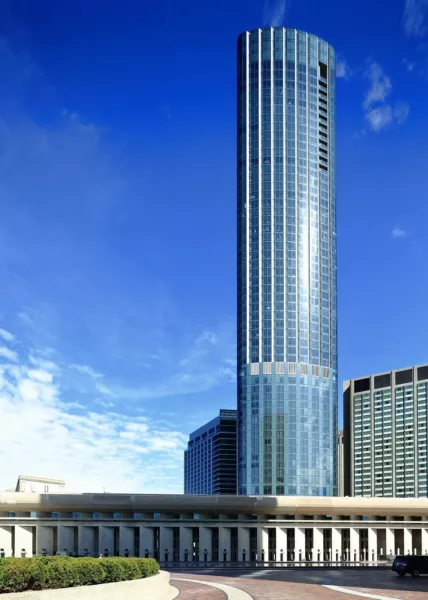
One Dalton: Four Seasons Hotel and Private Residences, designed by Pei Cobb Freed & Partners with CambridgeSeven, is a remarkable project located at the intersection of two vibrant neighborhoods in Boston, Massachusetts: the Back Bay and the western end of the city’s High Spine. The design of One Dalton expertly navigates the challenge of blending into a historic urban setting while accommodating the need for growth and modernity.
The juxtaposition of scales between the tree-lined streets of nineteenth-century townhouses in the Back Bay and the larger-scale complex in the High Spine presented a unique opportunity for the architects. With meticulous attention to siting, cascading scales, and materiality, One Dalton exemplifies how a tall building can integrate harmoniously within its context and create open spaces that enhance the urban fabric.
The design approach of One Dalton is a testament to the architectural prowess of Pei Cobb Freed & Partners with CambridgeSeven. The building not only fulfills the functional requirements of a luxury hotel and private residences but also respects and responds creatively to the surrounding historic urban setting. The careful consideration of siting and material choices ensures that One Dalton contributes to the visual and cultural richness of Boston.
15. Hollander Design Landscape Architects – Winner in Landscape Architecture / Residential
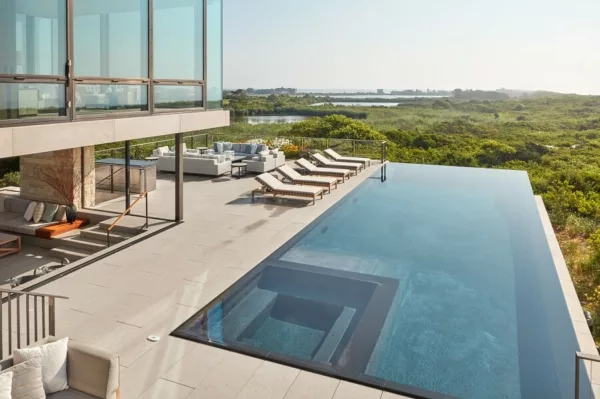
The Dune House, designed by Hollander Design Landscape Architects, is a captivating project nestled in a secluded oceanfront site. The landscape design prioritizes the breathtaking views of rolling dunes, the ocean, and the surrounding wetlands, creating a harmonious integration with the natural surroundings.
Recognized as a winner in Landscape Architecture / Residential, the Dune House embraces the site’s inherent beauty while working within the constraints of significant setbacks that protect the fragile wetlands and dunes. Rather than encroaching on the native landscape, the design team cleverly contained the home’s landscape within the building footprint, ensuring the preservation of the untouched natural environment.
The on-structure landscape of the Dune House reflects the spirit, forms, and color palette of the site’s exquisite native landscape. Clean and precise details, along with unobstructed views, allow the natural surroundings to take center stage. The sound of water adds to the sensory experience, creating a tranquil ambiance that keeps the focus on the captivating landscape beyond.
16. SPAN Architecture – Winner in Architectural Design / Small Architecture
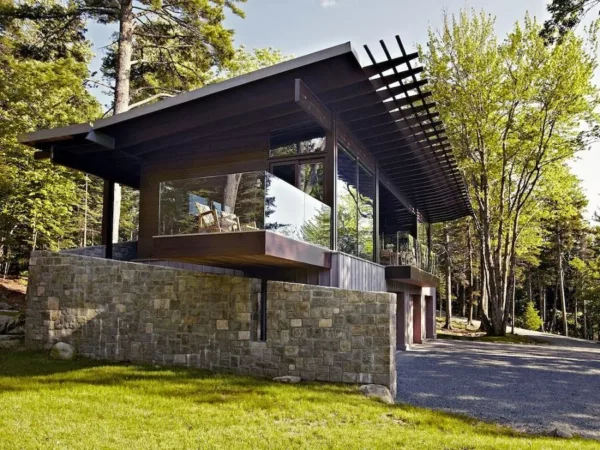
The August Moon Little House, designed by SPAN Architecture, is a captivating winner in the category of Architectural Design / Small Architecture. Nestled into the hillside and perched amidst the treetops, this unique dwelling celebrates the beauty of the rural landscape in Maine while offering a modern reinterpretation of the Craftsman Style tradition.
The Little House embraces the concept of flexibility and compact living. Every surface within the dwelling is designed to serve multiple purposes, allowing for a seamless integration of function and space. The dining table, for instance, folds out from the wooden shiplap wall, maximizing the utility of the compacted areas. A lightweight concrete shower wall opens to the exterior, providing an opportunity for outdoor bathing, connecting inhabitants with nature. Instead of traditional artwork, windows frame the stunning views, blurring the boundaries between the built environment and the natural surroundings.
The interior of the August Moon Little House seamlessly merges with the exterior, visually blending the built structure with the expansive views of the forest and the Great Western Bay. The design approach emphasizes a harmonious coexistence between the dwelling and its natural setting, offering inhabitants a serene and immersive experience.
17. BKSK Architects – Winner in Architectural Design / Commercial Architecture

529 Broadway, designed by BKSK Architects, is a captivating winner in the category of Architectural Design / Commercial Architecture. Located at the corner of Spring Street and Broadway in New York City’s SoHo Cast Iron Historic District, this transformative commercial building pays homage to its historical context while embracing contemporary design elements.
The building’s design draws inspiration from its predecessor, the Prescott House, a grand 19th-century hotel that was later reduced to a two-story taxpayer building in 1935. By comparing the original hotel to the neighboring 101 Spring Street, the innovative façade design showcases the evolution of cast iron’s role in the mid-19th century, transitioning from a decorative element to a structural component due to advancements in building technology.
The façade of 529 Broadway features an open-joint terra cotta rain screen that conceals a glass curtain wall. This composition allows the building’s exterior to transform across the site, seamlessly transitioning from a masonry building with punched openings reminiscent of the historic hotel to a modern glass curtain wall structure, reflecting the open and transparent nature of later cast iron buildings in the district. The terra cotta elements on the Spring Street elevation twist and dematerialize, serving as ornamental accents for the contemporary glass curtain wall with cast iron loft proportions on Broadway.
18. Studio V Architecture – Winner in Architectural Design / Restoration & Renovation

Empire Stores, a winner in the category of Architectural Design / Restoration & Renovation, showcases a remarkable transformation of historic brick structures that stood between the iconic Brooklyn and Manhattan Bridges for over 150 years. Led by Studio V Architecture, in collaboration with S9 and Perkins Eastman Architects, this project injects new life into the buildings, seamlessly blending creative contemporary architecture with meticulous historic rehabilitation.
The design approach for Empire Stores focuses on revitalizing the structures while creating an engaging and multi-functional space. The project masterfully combines overlapping uses, public spaces, and innovative design elements that celebrate both the inhabitants and the historic character of the site. Two-story glass and steel additions with gardens and terraces sit atop the buildings’ extensive green roofs, providing breathtaking views of the surrounding bridges.
A striking glass and steel courtyard and passage cuts through the historic structures, reconnecting the community to its waterfront. As visitors traverse this public passage, they encounter the original sparkling schist walls, creating a captivating blend of old and new. A spiraling steel and concrete staircase culminates in a public rooftop park, offering panoramic views of the Manhattan Skyline.
19. Fxfowle – Gold in Architectural Design / Green Architecture, Gold in Architectural Design / Tall Buildings, Silver in Architectural Design / Commercial Architecture

The Allianz Tower, a recipient of multiple awards including Gold in Architectural Design / Green architecture, Gold in Architectural Design / Tall Buildings, and Silver in Architectural Design / Commercial Architecture, stands as an iconic symbol in Istanbul. Designed by Fxfowle, the tower draws inspiration from the rich cultural heritage of its surroundings, integrating sculptural massing, a solar-responsive skin, and lush green spaces.
The design of the 40-story office tower reflects a deep understanding of the region’s cultural context. Taking cues from the unique landscape of Cappadocia, with its tower-like habitations emerging from rock formations, the tower incorporates elements reminiscent of Islamic ornamental geometries. The result is a faceted obelisk figure that shapes the overall form, building skin, and plaza design. The tower’s exterior is adorned with geometric mashrabiya screens, which not only add to its aesthetic appeal but also serve to regulate sunlight and provide privacy to the interior spaces.
A notable aspect of the Allianz Tower is its commitment to sustainability. As Turkey’s first LEED Platinum high-rise, the design embraces environmental consciousness. Sky gardens positioned strategically throughout the tower act as thermal buffers, reducing heat transfer between the exterior and interior while also serving as relaxation areas for employees. At the crown of the tower, a larger garden weaves together lush plantings and architectural elements, including a wood conference pod. These green spaces not only counterbalance the verticality of the building but also create a harmonious connection with nature.
20. Dean/wolf Architects – Gold in Architectural Design / Institutional Architecture

Restless Response: Queens Hospital Emergency Medical Station, a recipient of the Gold Prize in Architectural Design / Institutional Architecture, stands as a beacon of readiness and service in the heart of Queens, New York. Designed by Dean/wolf Architects, the EMS station was commissioned through the New York City Department of Design and Construction’s design excellence initiative.
The 13,000 square foot building is strategically located on the northern edge of the Queens Hospital campus, facing the residential-scaled Goethals Avenue. The design mediates between the existing ten-story hospital structure and the smaller two-story bungalows, seamlessly blending into the neighborhood fabric. The site’s unique topography, sloping in two directions, is skillfully integrated into the design. The gentle slope of the low roof mirrors the sloping of the street, reducing the perceived height of the street wall and maintaining a residential scale. Additionally, the upper bar at the rear of the site provides covered parking, optimizing the use of space.
The design takes into consideration the existing underground utility tunnel that traverses the site. To minimize construction near the tunnel, the structural approach employs two abutments that support a long-span truss for the second floor, effectively distributing the load away from the tunnel. The exterior of the building features taut glass and aluminum surfaces, imparting a sense of crispness and discipline while showcasing the constant readiness of the dedicated personnel within.
21. Studio Link-Arc – Gold in Architectural Design / Recreational Architecture

The China Pavilion for Expo Milano 2015, awarded the Gold Prize in Architectural Design / Recreational Architecture, defies conventional notions of a cultural pavilion. Designed by Studio Link-Arc, the pavilion is envisioned as a dynamic field of spaces nestled beneath a floating cloud. Its architectural form embodies the theme of “The Land of Hope” by seamlessly merging the profiles of a city skyline on the north side and a rolling landscape on the south side, symbolizing the harmony between urban and natural environments necessary for hope to flourish.
Beneath the distinctive roof, a landscaped field representing the concept of “Land” houses the exhibition program of the pavilion. The roof itself is a striking example of contemporary glulam technology, creating a spacious exhibition area that spans a multimedia installation. This multimedia centerpiece comprises 22,000 LED stalks integrated into the landscape, offering a captivating visual experience for visitors.
The roof is adorned with shingled bamboo panels, adding texture, depth, and visual interest to the silhouette of the pavilion. These panels were meticulously designed through a digital process, utilizing advanced computational techniques. The geometry of the panels was programmed directly using Processing, a software development environment, and subsequently optimized to closely follow the roof’s form while streamlining fabrication and construction processes.
22. Gensler – Platinum in Architectural Design / Commercial Architecture, Architectural Design of the Year

The Shanghai Tower, awarded the Platinum Prize in Architectural Design / Commercial Architecture and Architectural Design of the Year, stands as a monumental achievement in modern architecture. Designed by Gensler, this iconic skyscraper has become a symbol of Shanghai’s emergence on the global stage and showcases the remarkable fusion of technical innovation and Chinese cultural identity.
Rising as the tallest building in China, the Shanghai Tower has made a profound impact on the perception of skyscrapers and their role within a city, country, and culture. Its impressive form commands attention, yet its appearance remains delicate and graceful, making it a striking addition to any skyline. However, the true essence of the Shanghai Tower lies in its thoughtful integration with its specific site, responding to the needs and aspirations of the surrounding environment.
The tower’s design goes beyond mere aesthetics, emphasizing functionality, identity, and symbolism. It not only serves as a prominent landmark, but also sets an example for sustainable and technologically advanced architecture. The Shanghai Tower embodies the spirit of progress and innovation, showcasing how a skyscraper can shape a city and contribute to the cultural fabric of a nation.
23. Big – Bjarke Ingels Group – Silver in Architectural Design / Residential Architecture

VIA 57 West, awarded the Silver Prize in Architectural Design / Residential Architecture, redefines the concept of urban living with its innovative design and integrated sustainability features. Designed by BIG – Bjarke Ingels Group, this project introduces a new typology called the “courtscraper,” combining elements of the European perimeter block and the traditional Manhattan high-rise.
The building’s unique form creates a dynamic relationship between density and openness, privacy and views. By lifting the north-east corner towards its peak, VIA opens up to the Hudson River, allowing residents to enjoy expansive views and abundant natural light. The building’s courtyard, akin to a metropolitan backyard, is framed by the amenities of the building, providing a tranquil oasis in the heart of the city. From above, residents can gaze down upon their own private “Central Park.”
VIA 57 West also integrates commercial space on the ground floor, adding vibrancy and liveliness to the neighborhood. The building’s shape shifts depending on the viewer’s perspective, appearing as a tetrahedron from the West Side Highway and transforming into a striking glass spire from West 58th Street. The sloping roof features terraces, providing unique outdoor spaces for each apartment and optimizing the benefits of the surrounding views.
24. Rogers Partners – Silver in Architectural Design / Educational Buildings

The Henderson-Hopkins School, designed by Rogers Partners, is a groundbreaking educational facility in Baltimore. Inspired by the city’s row houses and civic spaces, the school features a cluster of “containers for learning” that foster a progressive environment for students. With its accessible design, community-oriented spaces, and emphasis on light and materiality, Henderson-Hopkins School is a testament to the future of education and its impact on the surrounding neighborhood.
Best Architecture Firms in New York: Igniting Innovation and Redefining Design Excellence
These firms stand at the forefront of architectural innovation and excellence, embodying the pinnacle of design expertise. With their distinct design philosophies and a plethora of remarkable projects, they have embraced the dynamic landscape of New York City as a canvas for their boundless creativity. The result is a collection of awe-inspiring structures that ignite the imagination and leave a lasting impression.
New York City is home to some of the world’s finest architecture firms, shaping the city’s skyline and setting new standards for design excellence. The 24 architecture firms mentioned above have left an indelible mark at the architecture awards through their exceptional projects and contributions to various domains of architectural design. From public spaces to cultural landmarks, their designs continue to inspire and redefine the possibilities of architecture.
